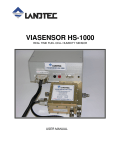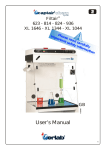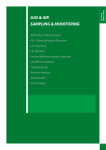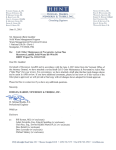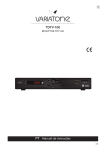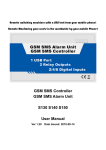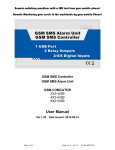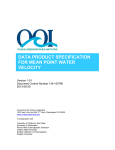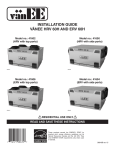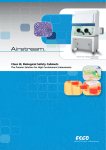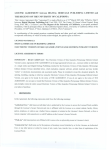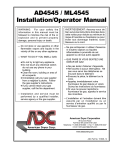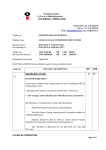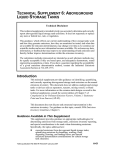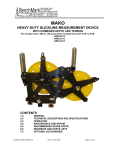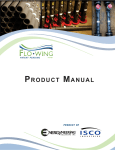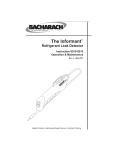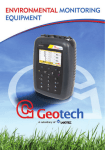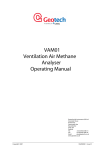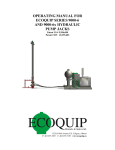Download Landtech GEM Manual
Transcript
™ GEM 2NAV Plus ™ GEM 2NAV ™ GEM 2000 Plus ™ GEM 2000 GAS ANALYZER & EXTRACTION MONITORS OPERATION MANUAL for Serial Numbers 10000 and up GEM2xxx Instruments Operation Manual ©Copyright 2009 by LANDTEC All rights reserved. No part of this book may be used or reproduced in any form or by any means, or stored in a database or retrieval system, without consent of the publisher. Making copies of any part of this book for any purpose other than your own personal use is a violation of copyright laws. LANDTEC and GEM are registered with the U.S. Patent and Trademark Office. For further information contact: LANDTEC North America 850 S. Via Lata, Suite 112 Colton, CA 92324 United States of America Sales Tel: +1 (800) 821-0496 or +1 (909) 783-3636 Sales Email: [email protected] Instrument Service Tel: +1 (909) 783-3636 x 6141 Software Support Tel: +1 (909) 783-3636 x 6131 Software Support Email: [email protected] Web: www.LANDTECNA.com LANDTEC Europe Formerly Geotechnical Instruments Sovereign House Queensway Leamington Spa, Warwickshire CV31 3JR England Tel: +44 (0) 1926 338-111 Web: www.geotech.co.uk LANDTEC South America LANDTEC Produtos e Servicos Ambientais Ltda. Rua Pedroso de Carmargo, 237 - Chácara Santo Antonio - SP/SP CEP 0417-010 Brasil Phone: +55 (11) 5181-6591 Web: www.landtecbrazil.com.br This manual is subject to revision without prior notice. website for a newer revision. Revision A Date Oct-2009 Approved by B B1 C1 C1a,b C2 Nov-2009 Nov-2009 16-Feb-2010 1-Mar-2010 Nov - 2010 MC & SM SM SM SM MC Page ii Translated from N/A N/A N/A N/A N/A N/A Please periodically check our Comment This document uses Arial, Wingdings, Wingdings 2, Wingdings 3, GI2k fonts. Printing of this document to PDF should only be done if these fonts are present. “Whitespace” has been removed from many of the graphical images and the images are otherwise “cropped” to reduce the total number of pages. These alterations of the actual screen images do not detract from the technical content presented1st Release of this manual Minor Corrections / Final Proofing Minor corrections to images Explanation of single media format & software installation. Environmental Chamber Clarified. H2S & CO specs modified Clarified instruments are not total hydrocarbon analyzers, cross gas interference and solutions for typical interferences. REV C2 (English) LANDTEC Release Date: November 30th, 2010 GEM2xxx Instruments Operation Manual Contents 1 INTRODUCTION ........................................................................................................................ 1 1.1 PHYSICAL CHARACTERISTICS OF THE GEM2XXX INSTRUMENTS .......................................................... 2 1.2 STORAGE ......................................................................................................................................... 3 1.3 BATTERY/CHARGING......................................................................................................................... 4 1.4 INSTRUMENT CERTIFICATION ............................................................................................................. 4 1.5 SAFETY INFORMATION ...................................................................................................................... 4 1.6 TURNING THE INSTRUMENT ON/OFF .................................................................................................. 5 1.7 WARM-UP SELF TEST ....................................................................................................................... 5 1.8 WARNING AND ERROR DISPLAY ......................................................................................................... 5 1.8.1 WARNING Displayed ............................................................................................................... 5 1.8.2 ERROR Displayed ................................................................................................................... 6 1.9 SERVICE INFORMATION SCREEN ........................................................................................................ 6 1.10 TECHNICIAN ID SCREEN ................................................................................................................... 6 1.11 GAS READING SCREEN ..................................................................................................................... 6 1.11.1 Keypad Lock ............................................................................................................................ 7 1.12 OPTIONAL GAS PODS ....................................................................................................................... 7 1.13 MEMORY ......................................................................................................................................... 7 1.13.1 Cold Start................................................................................................................................. 8 1.13.2 Recover Readings ................................................................................................................... 8 1.13.3 Print Readings ......................................................................................................................... 8 1.14 RADIO FREQUENCY (RF) INTERFERENCE ........................................................................................... 8 2 THE LANDTEC SYSTEM GAS ANALYZER MANAGER (LSGAM) SOFTWARE .................... 9 2.1 CONFIGURATION OPTIONS ................................................................................................................ 9 2.2 LANDTEC SYSTEM ONLINE USERS .................................................................................................. 9 2.3 OFFLINE USERS ............................................................................................................................... 9 2.3.1 Installation with the CD .......................................................................................................... 10 2.3.2 Startup ................................................................................................................................... 12 2.3.3 Navigation.............................................................................................................................. 13 2.4 CONNECTING TO THE INSTRUMENT .................................................................................................. 14 2.5 CREATE A PROJECT / SELECT A PROJECT ........................................................................................ 15 2.6 ID SETUP ....................................................................................................................................... 17 2.6.1 Creating Comments ............................................................................................................... 17 2.6.2 Creating IDs........................................................................................................................... 17 Importing DataField CS IDs ................................................................................................................. 22 2.6.3 Create a new project based upon IDs ALREADY IN THE INSTRUMENT: ............................. 22 2.7 CREATING YOUR SITE QUESTIONS ................................................................................................... 23 WORKING WITH DEVICE IDS ....................................................................................................................... 25 2.8 SENDING IDS TO THE INSTRUMENT .................................................................................................. 27 Clearing ID s from your instrument or Deleting a Project ...................................................................... 30 CLEARING THE INSTRUMENT MEMORY ........................................................................................................ 31 2.9 INSTRUMENT SETTINGS................................................................................................................... 32 2.9.1 Alarm Settings ....................................................................................................................... 33 2.9.2 Data Logging ......................................................................................................................... 33 EVENT LOG............................................................................................................................................... 34 2.10 MISC OPTIONS ............................................................................................................................ 35 2.11 UNITS OF MEASUREMENT ............................................................................................................ 37 DOWNLOADING READINGS ......................................................................................................................... 38 CLEAR READINGS ..................................................................................................................................... 39 EXPORTING READINGS .............................................................................................................................. 40 Page iii REV C2 (English) LANDTEC Release Date: November 30th, 2010 GEM2xxx Instruments Operation Manual GENERAL OPERATIONS MENU ..................................................................................................42 2.12 ZERO TRANSDUCERS .................................................................................................................. 42 2.13 UPDATE SITE DATA ..................................................................................................................... 43 2.14 DATA LOGGING (GA MODE ONLY) ................................................................................................ 43 2.15 OPERATING LANGUAGE ............................................................................................................... 43 2.16 VIEW DATA................................................................................................................................. 43 2.17 ADJUST CONTRAST..................................................................................................................... 43 2.18 FIELD CALIBRATION .................................................................................................................... 43 2.18.1 Zero Channels ....................................................................................................................... 44 2.18.2 Span Channels ...................................................................................................................... 44 2.18.3 Factory Settings .................................................................................................................... 44 2.18.4 Last Field Cal ........................................................................................................................ 45 2.19 MODE OF OPERATION ................................................................................................................. 45 2.20 INFORMATION SCREEN ................................................................................................................ 45 NAVIGATION ............................................................................................................................................. 45 2.21 EXIT MENU ................................................................................................................................. 45 3 TAKING PROBE READINGS (GA MODE) ..............................................................................46 3.1 PRELIMINARY CHECKS .................................................................................................................... 46 3.2 UPDATE SITE DATA ........................................................................................................................ 46 3.3 TAKING READINGS – W ITH ID.......................................................................................................... 46 3.4 TAKING READINGS – W ITHOUT ID ................................................................................................... 48 3.5 TEMPERATURE PROBE READING ..................................................................................................... 49 3.6 CROSS-GAS EFFECTS .................................................................................................................... 49 3.6.1 Methane, Carbon Dioxide and Oxygen .................................................................................. 49 3.6.2 H2S, CO and other Optional Gas Pods .................................................................................. 49 3.6.3 GEM2xxx Plus Internal Electrochemical Cells for Measuring H2S and CO ............................ 50 4 TAKING EXTRACTION WELL READINGS (GEM MODE) .....................................................51 4.1 4.2 4.3 5 PRELIMINARY CHECKS .................................................................................................................... 51 UPDATE SITE DATA ........................................................................................................................ 51 TAKING GAS AND FLOW READINGS (GEM MODE) ............................................................................ 51 FIELD OPERATIONS ..............................................................................................................54 5.1 LANDFILL GAS GENERATION ........................................................................................................... 54 5.2 SUBSURFACE FIRES ....................................................................................................................... 54 5.3 TECHNIQUES FOR CONTROLLING LANDFILL GAS............................................................................... 54 5.3.1 Controlling by Wellhead Valve Position ................................................................................. 55 5.3.2 Controlling by Wellhead Vacuum ........................................................................................... 55 5.3.3 Controlling by Gas Composition ............................................................................................ 55 5.3.4 Controlling by Flow Rate ....................................................................................................... 55 5.4 WELL FIELD MONITORING ............................................................................................................... 56 5.5 TYPICAL FIELD READINGS ............................................................................................................... 56 5.6 ABBREVIATED FIELD READINGS....................................................................................................... 56 5.7 WELL FIELD ADJUSTMENT CRITERIA ................................................................................................ 57 5.8 ESTABLISHING TARGET FLOWS ....................................................................................................... 57 5.9 WELL FIELD OPTIMIZATION ............................................................................................................. 58 5.10 MIGRATION CONTROL—DEALING WITH POOR METHANE QUALITY ..................................................... 58 5.11 WELL FIELD ADJUSTMENT—PURPOSE AND OBJECTIVES .................................................................. 58 Page iv REV C2 (English) LANDTEC Release Date: November 30th, 2010 GEM2xxx Instruments Operation Manual 6 TROUBLESHOOTING ............................................................................................................. 59 7 SERVICE & MAINTENANCE .................................................................................................. 60 7.1 7.2 7.3 FACTORY SERVICE ......................................................................................................................... 60 FACTORY SERVICE FACILITIES ......................................................................................................... 61 USER MAINTENANCE ...................................................................................................................... 61 TECHNICAL SPECIFICATIONS .................................................................................................... 62 7.4 7.5 7.6 7.7 7.8 7.9 7.10 7.11 Page v PHYSICAL....................................................................................................................................... 62 GENERAL ....................................................................................................................................... 62 POWER SUPPLY .............................................................................................................................. 62 GAS RANGES ................................................................................................................................. 62 PUMP ............................................................................................................................................ 63 OPERATING CONDITIONS ................................................................................................................ 63 OPTIONAL GAS PODS ..................................................................................................................... 63 REGULATORY COMPLIANCE LABELS AND STATEMENTS ..................................................................... 64 REV C2 (English) LANDTEC Release Date: November 30th, 2010 GEM2xxx Operation Manual 1 Introduction LANDTEC is the premier manufacturer of products, instruments and software for landfill gas extraction and regulatory monitoring compliance. LANDTEC has provided the landfill industry with a technologically innovative family of products for more than a decade. These products are the result of field-proven experience in design, operation and maintenance of landfills for environmental compliance. The GEM2000, GEM2000 Plus, GEM2NAV and GEM2NAV Plus instruments designed by LANDTEC, are specifically for use on landfills to monitor landfill gas (LFG) extraction systems, flares and migration control systems. These instruments sample and analyze the Methane, Carbon Dioxide and Oxygen content of LFG. The GEM instruments are not total hydrocarbon analyzers. The Plus versions (GEM2000 Plus and GEM2NAV Plus) also sample and analyze Carbon Monoxide and Hydrogen Sulfide. The NAV versions (GEM2NAV and GEM2NAV Plus) include an integral GPS (Global Positioning System). The readings are displayed and stored in the instrument and can be downloaded to a personal computer for reporting, analyzing and archiving. Since there are variations to the features of the instruments, this single manual is designed to cover all instrument versions. Throughout this manual, the term GEM2xxx is intended to refer to ANY of the GEM instruments with a serial number above 10,000. Features specific to one particular instrument will be designated within this manual to be specific for the particular instrument. The GEM instruments are shipped in a protective hard case with a foam interior that offers additional protection, transportation convenience and component hardware storage. When properly sealed, the hard case is watertight. The hard case is equipped with a pressure relief valve (located under the handle on the case) that is normally kept closed. If there is a change in elevation, the hard case may not open until the pressure relief valve is opened to equalize internal pressure. When shipping an instrument to LANDTEC for calibration or service, always ship it in the hard case to protect unit from damage. It is a good idea to also call and generate a Service or Repair Authorization (RA) prior to sending the instrument. This ensures proper routing of your instrument once it arrives at LANDTEC. The RA also will detail a list of reasons as to why the instrument is being returned for service. If an RA does not exist when the instrument arrives it can delay service of your instrument. Carefully unpack the contents of the instrument package, inspect and inventory them. The following items should be contained in your package: The GEM2000, GEM2000 Plus, GEM2NAV or GEM2NAV Plus instrument (Plus instruments have a Silver Keyboard and the numbers 1, 3, 5, 7, and 9 will be white on a blue background with a red highlight.) Operation Manual Registration/Warranty Card Soft carrying case with replaceable protective window and carrying strap Clear ¼‖ vinyl sampling hose assembly (5 ft.) with external water trap filter assembly Blue ¼‖ polyurethane pressure sampling hose (5 ft.) Spare internal particulate filter element Polypropylene male connector (hose barb) connects to blue & clear tubing Spare O-rings for the male connectors Spare external water trap filter element 100-240 volt battery charger Software on CD-ROM USB communications cable Temperature probe (optional) Hard carrying case Page 1 REV C2 (English) LANDTEC Release Date: November 30th, 2010 GEM2xxx Operation Manual Complete the Registration/Warranty Card and return it to LANDTEC. The model and serial numbers are located on the back of the instrument. Immediately notify shipping company if the instrument or accessories are damaged due to shipping. Please keep all packaging material and take pictures to document the damage. Next, contact LANDTEC immediately so that a claim can be established with the shipping company. For questions regarding instrument operation and procedures, please contact LANDTEC at the regional office of your choice. General Operational Features 1.1 Physical Characteristics of the GEM2xxx instruments Page 2 1 Exhaust Port 2 Temperature / Gas Pod / Communications Socket (Connector ―A‖) 3 Power Socket (Connector ―B‖) 4 Particulate Filter Housing (on back of instrument) 5 Sample Inlet, Static or System Pressure Port 6 Impact Pressure Port REV C2 (English) LANDTEC Release Date: November 30th, 2010 GEM2xxx Operation Manual 1.2 key key, up arrow, ‗‘ cursor key, scroll up key key, left arrow, ‗<‘ cursor key, scroll left key key, right arrow, ‗>‘ cursor key, scroll right key key, down arrow, ‗‘ cursor key, scroll down key key, (zero) key, Backlight operation, Keyboard Lock (press and hold for 2 second to activate keyboard lock, press again to deactivate the lock) Pump Operation, Pump On/Off, Backspace Key (press and hold for 1 second to backspace) Enter/Store key Red Power Button, On-Off (Press and Hold for 2-3 seconds for normal On-Off function, Press and Hold for 15 seconds to forcibly turn off the instrument) Storage Do not keep the instrument in the trunk of a car or shed because it may be exposed to temperature extremes. After use or before storing the instrument it should be purged with clean nitrogen or air. Purging with nitrogen may prolong the oxygen sensor‘s life. When not in use, instruments and accessories should be kept clean, dry and warm inside of their hard case. Page 3 REV C2 (English) LANDTEC Release Date: November 30th, 2010 GEM2xxx Operation Manual The instrument batteries should be discharged and fully charged at least once every four weeks regardless of indicated charge state. The discharge function may be carried out with the use of the Data Logging Function in GA mode of operation. 1.3 Battery/Charging The Battery Charger IS NOT covered by the unit UL certification. Warning - To reduce the risk of ignition of a flammable or explosive atmosphere, charge batteries only in an area known to be non-hazardous‖ or equivalent. The battery used in the GEM2xxx instrument is an encapsulated six cell, Nickel Metal Hydride pack. This type of battery is not as susceptible to ―memory effects‖ as Nickel Cadmium batteries, although it is not recommended that the unit be given short-term charges. When the flashing LED indicates ―Trickle Charge‖ the charging is completed and the unit should be disconnected from the charger. The battery charger indicates when the unit is charging, charged or if there is a fault. A full charge should take approximately 2 hours. 1.4 Instrument Certification The GEM2xxx is UL/Sira certified for use in hazardous locations. Specifically certified as to intrinsic safety for use in hazardous locations Class I, Zone 1, AEx ib d IIA T1 (Ta=32°F to +104°F). When the GEM2xxx instrument is in the hazardous area it shall only be externally attached via connector A to devices that are marked with the UL File Number E203142 For the certification to remain intact it is vital that the instructions in this manual are followed closely and repair of this equipment be carried out in accordance with the applicable code of practice by an approved repair facility. See section 7.2 for a list of authorized repair locations. It is the responsibility of the operator to determine the protection concept and classification required for a particular application. 1.5 Safety Information The GEM2xxx instruments are normally used for measuring gases from landfill sites. Inhalation of any gas may be harmful to health and in some cases may be fatal. It is the responsibility of the user to ensure that they are adequately trained in the safety aspects of the gases being used and that appropriate procedures be followed. In particular, where hazardous gases are being monitored or used the gas exhausted from the analyzer must be piped to an area where it is safe to discharge the gas. Hazardous gas can also be expelled from the instrument when purging with clean air. Page 4 REV C2 (English) LANDTEC Release Date: November 30th, 2010 GEM2xxx Operation Manual 1.6 Turning the Instrument On/Off When switching the instrument on, a long beep will sound, followed by the LANDTEC logo being displayed and the self-test will commence. Whenever a key is pressed the unit will emit a short ‗beep‘ as an acknowledgement. This function cannot be turned off. When switching the instrument off, the On/Off button must be held down for approximately 2-3 seconds, at which point a clean air purge will be carried out. If for any reason the instrument ‗locks-up‘ and will not switch off, press and hold the On/Off button for 15 seconds. This will force the instrument to switch off. 1.7 Warm-up Self Test When switched on, the instrument will briefly display the LANDTEC logo and perform a predetermined selftest sequence taking approximately 30 seconds, during this time many of the instrument‘s functions are tested, including: General operation Pump function Gas flow measurement Calibration Backlight function Solenoid function During the self-test, the following information is also displayed: Software version Serial Number Calibration due date Date format Operating language Communication Baud rate Depending upon your version of GEM2xxx instrument you may see additional items listed from the self-test as well. 1.8 Warning and Error Display During the self-test, if any operational parameters are out of specification or the pre-programmed recommended calibration/service date has passed errors or warnings may be displayed. Only three errors/warnings can be displayed at any time. To ascertain if more errors occurred, use the ‗‘ and ‗‘ key to scroll up/down the list, to exit from this screen press the ―Enter/Store‖ key ‗‘. 1.8.1 WARNING Displayed All warnings displayed will be prefixed by the word ‗‗WARNING‗ followed by a relevant description. Two types of warnings may be displayed. 1. General warnings that may not have an effect on the instrument‘s function and those where the self-test has detected a function that is outside the usual programmed operating criteria (e.g. Battery charge low, memory nearly full, etc.). 2. Specific warnings of operational parameters that can affect the performance of the instrument (e.g. O2 Cell out of calibration, CH4 out of calibration, CO2 out of calibration, etc.). The most likely reason for the errors is either an incorrect user calibration, or sensor failure. If an incorrect user calibration has caused the warning, it should be correctable by way of returning the instrument to factory settings, zeroing or carrying out a user calibration as necessary for the relevant function. Page 5 REV C2 (English) LANDTEC Release Date: November 30th, 2010 GEM2xxx Operation Manual 1.8.2 ERROR Displayed All errors displayed will be prefixed by the word ‗ERROR‗ followed by a number and description. The errors detected by the self-test are usually caused by a user calibration being out of specification or possibly memory corruption. This will have an effect on the functionality of the instrument and should be corrected before use (e.g. 01 - User cal data, CH4 reading or channel out of specification, 02 - User cal data, CO2 reading out of specification). If any other Warnings or Errors are displayed, contact a LANDTEC Authorized Service Facility for further information. 1.9 Service Information Screen Upon self-test completion, the instrument will display service information including when the next manufacturers service is due, what type of service agreement the instrument is under (if applicable), and when the last factory gas check was performed. To exit from this screen press the ―Enter/Store‖ key ‗‘. 1.10 Technician ID Screen The Technician ID screen is displayed after the Service Information screen. It is not necessary to input a Technician ID but it is suggested to do so for record purposes. Up to four characters can be entered to identify the technician performing the readings. This technician ID will be appended to all readings that are taken until the instrument is turned off. To change the Technician ID simply turn the instrument off and back on again. The Technician ID can be input through a virtual key board shown on the instruments display. Letters or numbers can be selected by using the ‗‘ and ‗‘ keys to scroll up/down and the ‗‘ and ‗‘ to scroll left and right. Pressing the ―Enter/Store‖ key ‗‘ will select the highlighted character. Once the Technician ID is selected, or to bypass selecting any characters press the ‘‘ button. 1.11 Gas Reading Screen After inputting or bypassing the Technician ID, the instrument will go into the Gas Reading screen, also considered the normal operation screen. All operations are carried out from this starting point. The following information is displayed in various boxed sections at this time: Current programmed time and date Current selected ID code Pump status Pump run time Three main constituent gases – CH4, CO2, O2 (in %) Two minor gases – CO & H2S and indication of H2 (GEM2xxx Plus instruments only) Balance gas Last read time/date (if previous data is in memory) Technician ID External devices (displays pod type or temperature probe readings when attached) % LEL CH4 (if selected through LSGAM) Barometric pressure reading. Current relative pressure reading (GA mode only) Gas Pod or Temperature Probe reading (if connected) Battery Charge graph (5 segment, flashes at 20% remaining) Memory Usage graph (5 segment, flashes at 5% remaining) Other options: Menu Next ID / GPS Screen / Measure Flow Previous Reading Store Reading Page 6 Allows access to all instrument user functions. Allows the next ID to be selected (if IDs are available). (GPS Screen is for GEM2NAV Models when ID‘s are not used) For GEM mode only. Allows the previous reading of the selected ID to be viewed (if data is available). Stores the current displayed reading. (GA mode only) REV C2 (English) LANDTEC Release Date: November 30th, 2010 GEM2xxx Operation Manual 1.11.1 Keypad Lock After the instrument enters into the Gas Reading Screen, and from this point forward, the keypad can be locked by pressing and holding the backlight key for approximately 2 seconds. A message will display at the bottom of the display instructing you that to release the lock you will need to press and hold the backlight button. 1.12 Optional Gas Pods Optional Gas Pods are available for use with the instruments. These pods are available for a variety different gases. For certain gases, more than one PPM range may be available; consult with a sale representative for the Gas Pod that would best meet your specific needs. Connection to the instrument is made via the communications socket and exhaust port. The detected PPM level is displayed in the upper right area of the gas read screen and is saved in the same manner as the other gas readings. The Gas Pods are not classified as intrinsically safe they should not be attached or detached from the instrument in hazardous areas. Gas Type H2S CO SO2 H2 HCN Range (PPM) 0-50 0-200 0-5000 0-1000 0-20 0-100 0-1000 0-100 Resolution (PPM) 0.1 1.0 35 1.0 0.1 1.0 1.0 1.0 Gas Pods are intended for use as an inexpensive detection means and not for regulatory reporting purposes. If a Gas Pod, indicates the presence of the pod‘s selected gas, further testing should be performed with regulatory approved instrumentation. LANDTEC recommends that field calibration be performed using the relevant gas and concentration, prior to sampling with a Gas Pod. If calibrated properly, the accuracy of these Gas Pods are typically 5-10% Full Scale. Certain gases used to calibrate gas pods may be dangerous or fatal to your health. Be familiar with material safety data sheets (MSDS) prior to using any gas. 1.13 Memory The instrument's memory is volatile. It is maintained by a battery back-up system, which will maintain the memory while the battery is being charged. The memory is not to be used as a permanent storage medium and any data should be downloaded to a computer with permanent storage as soon as possible. An Instrument should never be stored for prolonged periods with valuable data in its memory. When using the instrument please cover the communications and charging sockets with their ―dust plugs‖. Although unlikely, sudden shocks, high levels of electromagnetic interference or static discharge may cause memory corruption or loss. Additionally the use of cell phones or other high powered devices near the instrument may cause radio frequency interference and may cause memory corruption or loss. If this occurs, the instrument may need to be Cold Started and the calibration reset to factory settings before further use. NOTE: Cold Starting will erase all data in the instrument including resetting the following to default values: Time and Date Language Settings Screen Contrast Setting Mode of Operation Field Calibration Page 7 REV C2 (English) LANDTEC Release Date: November 30th, 2010 GEM2xxx Operation Manual 1.13.1 Cold Start THIS FUNCTION SHOULD BE USED ONLY AS A LAST RESORT. (For Gas Calibration Error Messages, confirm that Factory Settings and User Calibration are done). A Cold Start should only be carried out to correct an instrument if no other course of action has proved successful. This function WILL ERASE the instrument memory entirely. After a cold start is performed the user will need to reset the instrument to factory settings, perform a field calibration, reset the internal time/date to the default settings, and load device IDs into the instrument. Please note that the time/date and device IDs may only be updated through the communication software. They cannot be updated manually. To carry out a cold start, turn the instrument on, before the instrument enters into the self-test screen press and continue to hold the ‗‘ key until a pass code entry screen is displayed. At this point the ‗‘ key may be released. Enter the pass-code 12345 and press ‗‘ to confirm. After the pass-code entry has been accepted, the instrument serial number will be displayed along with the hours in use, pump run time and service dates. There are four options from this screen; 1230- Cold Start Recover readings Print readings Exit ONLY select option ‗1’ if a Cold Start is to be carried out. Press key ‗1‘ to confirm this operation or press key ‗0‘ to continue with normal operation. If you select ‗1‘ to confirm the cold start a message will be displayed confirming the cold start operation and all memory will be cleared. The instrument will continue to the technician ID screen. 1.13.2 Recover Readings THIS FUNCTION SHOULD BE USED ONLY AS A LAST RESORT. Recover readings is a low level memory function that should only be used as a last resort if all your readings were inadvertently deleted and you know how many readings you had. This function moves the memory buffer and can cause instrument corruption. Contact LANDTEC before attempting to recover readings. After using this function, it is recommended that you download data from the GEM and then perform a cold start to ensure all memory is cleared and returned to an initialized state. 1.13.3 Print Readings This function is performed as a technical support diagnostic tool and can assist LANDTEC personnel in troubleshooting certain types of problems. 1.14 Radio Frequency (RF) Interference The gas sensors, especially the Methane sensor, are sensitive to RF interference. Any device that transmits radio waves can cause your gas readings to fluctuate. Cell phones are the most common cause of the problem. You should never use your cell phone while you are taking gas readings. Page 8 REV C2 (English) LANDTEC Release Date: November 30th, 2010 GEM2xxx Operation Manual 2 The LANDTEC System Gas Analyzer Manager (LSGAM) Software Beginning with GEM2xxx serial number 10000 and above, LSGAM is the only software that will communicate with the instrument. 2.1 Configuration Options The GEM2xxx and LANDTEC System Gas Analyzer Manager (LSGAM) software can be utilized in a number of ways: Configured for operation with the LANDTEC System online service Used offline as a local application storing information on the desktop/laptop computer Use of the GEM2xxx out of the box without software; (this does not allow the user to generate flow rate values, select comments or select IDs with the instrument. This also prevents downloading of readings to the computer. It also does not allow the user to correct the time and date or to clear the memory, unless cold started.) 2.2 LANDTEC System Online Users The procedures included in this section are intended for those who connect to the LANDTEC System online service. The LANDTEC System is an online collaboration tool to Collect, Validate, Analyze, and Communicate information based on field data obtained using LANDTEC instrumentation. If you are a currently registered user on the LANDTEC System, please log in at http://www.landtecsystem.com/. If you are not currently using the LANDTEC System, you may register by contacting LANDTEC in the US: (800) 821-0496 or International: +1 (909) 783-3636. Online reference for using LANDTEC System Gas Analyzer Manager (LSGAM) with the LANDTEC System can be found under the About Help & Support menu within the LANDTEC System. If you do not have login information please contact LANDTEC System Technical Support at +1 (909) 783-3636 extension 6131. Alternately, you may contact your local LANDTEC office for information on connecting to the LANDTEC System online service. 2.3 Offline Users The procedures included in the section describe use of the LANDTEC System Gas Analyzer Manager (LSGAM) Software while NOT connected to the LANDTEC System online service. Page 9 REV C2 (English) LANDTEC Release Date: November 30th, 2010 GEM2xxx Operation Manual 2.3.1 Installation with the CD System Requirements Windows XP, Vista, 7 Pentium 750MHz or faster 128MB RAM 200MB Hard Drive Space Available CD-ROM Drive Available USB port NOTE: The computer may need some administrative privileges to install the program. Program may run on other versions of Windows but LANDTEC has not tested the program on older versions of windows or with lesser processor and memory requirements. As part of LANDTEC‘s continual improvement process, LANDTEC has consolidated its product information and instrument communications software into one menu structure. On your memory stick or CD you will find technical information, instrument communication software, USB cable drivers, videos and instrument manuals. To install the USB Cable Drivers and LSGAM (instrument communication software) from this media format, you will need to place your CD or memory stick into your computer. If you have a CD it should automatically start. If you have a memory stick, you may have to browse to it in your computer and then click on the ClickHereToStart.htm icon. Once the media opens, you will need to choose your appropriate application area from one of the application categories. This example is for a GEM2NAV instrument being used on a Landfill Gas application. After the page opens you‘ll click on the link titled Instrument Communications Software (LSGAM) & USB Cable Driver. Step A —Click on LANDFILL GAS Step B —Click on Instrument Communications Software (LSGAM) & USB Cable Driver Step C —Install Components of the Instrument Communication Software Step D —Choose ―Step 1 – Install USB Drivers‖ Page 10 REV C2 (English) LANDTEC Release Date: November 30th, 2010 GEM2xxx Operation Manual Step E —Choose ―Step 2 – Install LSGAM Software‖ The software will automatically update if an internet connection is available when the software starts. This software has been tested with Windows XP. Partial testing on Windows Vista and Windows 7 is complete and the software is performing as expected. Should you have any difficulties, please don‘t hesitate to contact us. Our Software support group can be reached at (909) 783-3636 x6131 or [email protected] The instrument communicates to the computer by means of a USB. This USB cable requires drivers to be installed prior to use on the computer. From the CD (or USB memory stick) choose the first option ―Step 1— Install USB Drivers‖ The Java programming is an import part of this software and will be loaded with the CD install. If you have internet access, it is recommended to update your java to the latest version by going to http://www.sun.com Page 11 REV C2 (English) LANDTEC Release Date: November 30th, 2010 GEM2xxx Operation Manual then click the Java Icon under the ―downloads‖ section. Once at the Java downloads you‘ll see links to download the latest version of Java for your computer. The java icon, shown below, will be in the task tray at the bottom of your computer screen where your time is shown. There will also be a GAM log icon, shown below, that will be created on your desk top during installation. 2.3.2 Startup Up Once the USB cable drivers are installed and you‘ve checked for the latest Java Runtime from the www.sun.com website, click on ―Step 2 — Install LSGAM‖. LSGAM will install placing an Icon on your desktop and a new Start Menu Group named LANDTEC. Starting LSGAM can be easily done by doing one of the following: Double-Click on the Desktop icon. OR - go to; Start All Programs LANDTEC LANDTEC System Gas Analyzer Manager Page 12 REV C2 (English) LANDTEC Release Date: November 30th, 2010 GEM2xxx Operation Manual 2.3.3 Navigation The LANDTEC System Gas Analyzer Manager User Interface allows for easy access and navigation to various utilities to use the LANDTEC portable instrument on a day to day basis. The following is a general description of the user interface. LANDTEC System Login When LSGAM is used with the LANDTEC System online service, the username and password will be entered in the screen below, if you are using LSGSM as a desktop application the User Id and Password fields do not need to be filled in. The Progress section indicates the status of the current process. For example, when starting up LSGAM, this will show you the activity of the software. The Instrument section displays whether or not an instrument is connected. This also downloads the IDs, readings, and comments. If an instrument is found the following details are shown about the instrument: Page 13 REV C2 (English) LANDTEC Release Date: November 30th, 2010 GEM2xxx Operation Manual 2.4 Connecting to the Instrument 1. Connect the GEM2xxx with the USB or RS-232 Download Cable to your Computer 2. Instrument must be powered ON and in the Gas Reading screen 3. Launch the LSGAM software by clicking on the icon on your desktop This is the first screen you will see when starting the program. Once the software is installed on your computer with an internet connection this instrument communications program has Auto application updates. This enables you to always have the most current version of the instrument communications LSGAM. If an update to LSGAM is available, you will see this notice when connected to the internet. Page 14 REV C2 (English) LANDTEC Release Date: November 30th, 2010 GEM2xxx Operation Manual Click on OK this will return you to the desktop and you will then need to click on the again. LSGAM shortcut The GEM2xxx must be connected to computer and turned ON. It must also be in the Gas Reading screen. The LSGAM software will automatically download any information in the instrument including readings, comments and IDs. Note: Connection of instrument to computer should not be performed in a hazardous area. A new instrument containing no information will display only the instrument information: Serial Number, Version, Operating Mode, Instrument Date, Service Due Date, Number of IDs, Number of Readings, Available Memory, and Battery Level. 2.5 Create a Project / Select a Project Projects are a collection of Device IDs and their associated reading history. A project can be created using LSGAM to contain a group of sequenced IDs and chronological history of instrument readings. To create a Project, click on the Project menu and select New Project. Page 15 REV C2 (English) LANDTEC Release Date: November 30th, 2010 GEM2xxx Operation Manual Upon selecting New Project… you will be prompted to enter a Project Name and select from one of three options. Create a New Empty Project This option creates a blank project where you configure all IDs and Comments. Create a New Project with comments and site questions from a Current Project Selecting this option allows the user to create a new project that will have the same Comments and Site Questions as an existing project. Create a New Project from the data in a GEM2xxx instrument This option will create a New Project and automatically associate the IDs, Comments, and Site Questions that exist in the connected portable instrument. Page 16 REV C2 (English) LANDTEC Release Date: November 30th, 2010 GEM2xxx Operation Manual 2.6 ID Setup An ID represents a physical sampling point in the field. An ID can be allocated to field components such as extraction wellheads, gas transmission lines, or passive monitoring probes. LSGAM allows users to configure an ID for each sampling point in order to obtain accurate readings with LANDTEC portable instrumentation IDs are created, modified, and removed from the Project Setup tab in the software. 2.6.1 Creating Comments Comments should be setup prior to creating new IDs. The user can define Comments that can be associated with a reading in the portable instrument. If you selected Create a New Project, when creating your project, you will need to click on the Create Comments button. Comments can be entered in this setup screen or loaded from a file and will be displayed in the user interface. Typical Comments Might Include Valve Fully Open Valve Partially Open Valve Closed Air Leak in Wellhead Water Blockage in Header Surging at well Sample Port Needs Replacement More Vacuum Needed 5 Day Recheck 2.6.2 Creating IDs There are several ways to input IDs to the Project. The following describes each process: Creating new IDs with LSGAM To create a new ID using the LANDTEC System Gas Analyzer Manager, Right Click on the left ID pane beneath your active project and select the Add New ID option. The Add New ID form will be displayed. From the ID Information tab of this form, entry of the following is Page 17 REV C2 (English) LANDTEC Release Date: November 30th, 2010 GEM2xxx Operation Manual available: Note: LAT & LONG will only be available on GEM2NAV models ID INFORMATION Device ID: Must be eight (8) alphanumeric character spaces. (For example, ALFGW001) Device Type: Well: An active gas extraction well connected to a piping network which may require a flow rate reading. Sample Port: A sample point along a gas transmission line that may require a flow rate. Probe: A passive gas migration monitoring probe that does not require a flow rate. The GEM2xxx calculates flow rate values specific to each device type (listed above). The available flow devices programmed in GEM mode are listed below. Page 18 REV C2 (English) LANDTEC Release Date: November 30th, 2010 GEM2xxx Operation Manual Temperature Port Flow Devices: System Pressure Port Static Pressure Port Impact Pressure Port Figure 1 - ACCU-FLO Vertical Wellhead Temperature Port Impact Pressure Port Static Pressure Port System Pressure Port Figure 2 - ACCU-FLO Horizontal Wellhead Page 19 REV C2 (English) LANDTEC Release Date: November 30th, 2010 GEM2xxx Operation Manual Impact/Total Pressure Port Static Pressure Port Figure 3 - Pitot Tube Static Pressure ―L‖ Impact Pressure/ ―L‖ Static Pressure ―H‖ Figure 4 - Orifice Plate (WellSide) Page 20 / / Impact Pressure/ ―H‖ Orifice Plate REV C2 (English) LANDTEC Release Date: November 30th, 2010 GEM2xxx Operation Manual Flow Device Name Programmed in GEM Orientation Size ACCU-FLO 1.5V ACCU-FLO 1.5H ACCU-FLO 2V ACCU-FLO 2H ACCU-FLO 3V ACCU-FLO 3H Orifice Plate Pitot Tube User Input Orifice Plate WellSide ACCU-FLO-1.5V (System Pressure) ACCU-FLO-1.5H (System Pressure) ACCU-FLO-2V (System Pressure) ACCU-FLO-2H (System Pressure) ACCU-FLO-3V (System Pressure) ACCU-FLO-3H (System Pressure) Orifice Plate-System Side (System Pressure) Pitot Tube (System Pressure) User Input (System Pressure) Orifice Plate WellSide (System Pressure) Vertical Horizontal Vertical Horizontal Vertical Horizontal 1.5 inch 1.5 inch 2.0 inch 2.0 inch 3.0 inch 3.0 inch Vertical Horizontal Vertical Horizontal Vertical Horizontal 1.5 inch 1.5 inch 2.0 inch 2.0 inch 3.0 inch 3.0 inch System Pressure Pipe Diameter: The pipe inside diameter (ID) is required for Orifice Plate and Pitot Tube type flow devices. Orifice Diameter: The field for orifice bore diameter is available for all Orifice Plate flow devices. Pump Run Time: Indicates the duration the instrument‘s pump will run while sampling for the selected ID. Device Information: Allows the user to enter general information for the device. This will display on the screen of the instrument if the user chooses the View ID Details option from the ID selection screen on the instrument. ID QUESTIONS There are 5 Question Types that can be selected: None - No question will be prompted to the user Alphanumeric - An alphanumeric answer can be entered when taking a reading Numeric - A numeric only answer can be entered when taking a reading Multiple Comment selection - Up to 8 comments that may be appropriate for this device ID can be selected in the ID setup. Then one or all of the comments can be selected when taking a reading. Single comment selection - Up to 8 comments that may be appropriate for this device ID can be selected in the ID Setup but only one comment can be selected when taking a reading. Comments related to valve position are often used with a Single Comment Selection because the valve can only be in one position. Page 21 REV C2 (English) LANDTEC Release Date: November 30th, 2010 GEM2xxx Operation Manual Importing DataField CS IDs If you have existing ID files from DataField CS v3.2.x, these files can be imported by LSGAM. To begin this operation select the Import IDs… option from the Project menu. Select an ID file generated by DataField CS v3.2.x. 2.6.3 Create a new project based upon IDs ALREADY IN THE INSTRUMENT: To create a Project based on the information in the instrument, select Create a new project from the data in my instrument. Page 22 REV C2 (English) LANDTEC Release Date: November 30th, 2010 GEM2xxx Operation Manual Note: When using the Creating a new project from the data in the instrument option, only IDs NOT associated with other projects will be created into the new project. Creating a Device ID that does not measure flow Example- Probe or Sample Port If there is no flow device you will choose User Input. When choosing the User Input option you will need to enter the appropriate pipe inside diameter and pump run time. This ID is then generally sent to the GA mode [Landfill Gas Analyzer] of the instrument. Because this mode of the instrument does not read flow will not show the pressure readings screens that are in the GEM mode for vacuum and impact pressures. 2.7 Creating your Site Questions Site questions are setup in the same manner as ID questions however unlike ID questions, the answers for Site questions will apply to all subsequent readings until the site question is updated. A total of 5 site questions can be sent to your instrument. These must be updated each time you use the GEM. This is done by going to the Menu selection on the instrument and choosing [Update Site Data] Page 23 REV C2 (English) LANDTEC Release Date: November 30th, 2010 GEM2xxx Operation Manual The options for questions are Alphanumeric – Numeric – Multiple or Single comment selection. These Site Questions may be used again with another project by selecting the Create New Project and create new project with comments and site questions from current project. The project will be created and the IDs, Comments, and Site Questions that exist in the instrument will be applied to the new project. Page 24 REV C2 (English) LANDTEC Release Date: November 30th, 2010 GEM2xxx Operation Manual Working with Device IDs Once some IDs are added to your project you may need to occasionally edit them or reference them. First select the project which you want to work with from the project drop down list. Placing the mouse cursor over a specific device ID will show detailed information about that ID. To edit a Device ID, right click on the desired device and select Edit Device ID. To delete an existing ID, right click on the desired device and select Delete Selected Device ID(s). Page 25 REV C2 (English) LANDTEC Release Date: November 30th, 2010 GEM2xxx Operation Manual Upon clicking on Delete Selected Device Id(s) you will see the line strikeout. * The computer Icon will now display a red over the image . This indicates that the IDs are NOT saved. Deleted IDs are displayed with a line through the information on the screen. To restore a deleted ID, right click on the ID and click Restore Selected Device ID(s). Note: Deleted ID‟s can only be restored while the project state is unsaved. Once saved, the ID changes are saved and restoration cannot be completed. Once all work with the device ID‘s is complete, click on the Save button. After clicking on OK, the device is removed and the computer icon returns to the unaltered state Page 26 . REV C2 (English) LANDTEC Release Date: November 30th, 2010 GEM2xxx Operation Manual 2.8 Sending IDs to the instrument Once IDs have been created in the project, they must be uploaded to the instrument. To perform this operation, select the desired IDs from the left hand table under the Project name (computer side), left click and hold while dragging the IDs to the right hand table and release the mouse button. This is action is know as a ―Drag & Drop‖. Three basic methods of selecting IDs exist. Select Specific ID(s) Select a Range of IDs Select All IDs Specific IDs To Select Specific List of IDs, place the mouse arrow at the edge of the first cell and hold down the left Ctrl key. Now click the next ID cell that you wish to select. Repeat this as many times as necessary. Selected IDs (shown as Highlighted). Arrow depicts "Drag & Drop" action after selection. Now ―Drag & Drop‖ the IDs from the left (computer window) to the right (instrument window). During the ―Drag &Drop‖ process, the arrow will change to . The selected IDs ALFP001, ALFMW002, and ALFMW004 now appear on the Right (Instrument) side. At this point the IDs are on the Instrument side but have NOT been sent to the instrument. The instrument * with the red indicates this unsent ID state. Click on the Send to Instrument button send these IDs to the instrument. Page 27 to REV C2 (English) LANDTEC Release Date: November 30th, 2010 GEM2xxx Operation Manual After the IDs are sent to the instrument, the instrument will appear without the red * Range of IDs To Select A Range of IDs, place the mouse arrow at the edge of the first cell and hold down the left shift key. Now click the last cell in the range. The entire selected range will now be selected. As with selecting specific IDs once the IDs are selected, they are moved to the Instrument side by ―Drag & Drop‖. The Instrument icon will appear with a red * and the ID‘s will need to be sent to the instrument. Click on the Send to Instrument button to send these IDs to the instrument. Selecting All IDs All IDs can be selected by selecting one ID in the Project window and then pressing Ctrl-A. Page 28 REV C2 (English) LANDTEC Release Date: November 30th, 2010 GEM2xxx Operation Manual Now move IDs from the Project Side to the Instrument Side by dragging and dropping them. If you are dragging and dropping an ID that is already on the instrument side, you will be prompted with the above message. Answer Yes to update the IDs on the instrument side from those on the computer side. Answer No to ignore IDs that are already in the instrument. Answer Cancel to cancel the action without sending ID‘s to the instrument side. Click on the Send to Instrument button Page 29 to send these IDs to the instrument. REV C2 (English) LANDTEC Release Date: November 30th, 2010 GEM2xxx Operation Manual Clearing ID s from your instrument or Deleting a Project In current instrument contents when selecting the Clear ID List option it will draw lines through the IDS. You then need to select Send to Instrument. This will clear all IDs from the GEM2xxx in both the GEM and GA mode. You may also delete one ID from a list by highlighting the ID RIGHT CLICK with your mouse and select the Delete Selected Device option. If you have selected the wrong ID and deleted then you may select the Restore option to return the ID to the list. Page 30 REV C2 (English) LANDTEC Release Date: November 30th, 2010 GEM2xxx Operation Manual Upon selecting Delete Selected Device Id(s) you will see a strikeout line appear through the ID Click on the Send to Instrument button to send the ID corrections to the instrument. The instrument contents will now be updated and the ALFMW004 ID no longer shows in the instrument side of the list. Clearing the Instrument Memory The Clear Instrument Memory function allows various parts of the instrument‘s memory to be cleared. Upon clicking on the Clear Instrument Memory button the following options are available. Page 31 REV C2 (English) LANDTEC Release Date: November 30th, 2010 GEM2xxx Operation Manual Please Note: Clear functions in the instrument affect both GEM and GA modes of instrument operation. Upon selecting a memory type to clear, and clicking OK, a prompt will appear to confirm the selected action. Answer Yes to perform the action. Answer No or Cancel to return to the clear memory dialog. 2.9 Instrument Settings The LANDTEC System Gas Analyzer Manager software allows users to change many of the operational settings of the instrument. To view and change the available settings click on the Instrument Configuration tab. In the Instrument Configuration user interface, there is an Instrument Settings option tree. The Instrument Settings tree allows for easy navigation to the following categories: Alarm Settings Data Logging Date/Time Settings Misc Options Units of Measurement Page 32 REV C2 (English) LANDTEC Release Date: November 30th, 2010 GEM2xxx Operation Manual The following sections describe each option category. 2.9.1 Alarm Settings The Alarm Settings options control the activation and deactivation of the audible alarms in the GEM2xxx instrument. Audible alarms can be configured for CH4, CO2, and O2 parameters. Each parameter can be configured with a Low Trigger and/or High Trigger for the alarm. To activate any specific alarm, click and place a checkmark in the desired box. This will activate the entry field to place the value. The values must be 0 – 100 percent. When alarms are set, the instrument will beep and flash the parameter on the screen if an alarm threshold is surpassed when taking a gas reading. 2.9.2 Data Logging Note: This feature of the instrument is available in GA Operational Mode Only Data Log ID The Data Logging option allows the user to specify an ID to be associated to readings taken with the Autologging feature of the instrument. Time Between Readings This value indicates the time from when the pump stops running until the pump begins sampling. Pump Running Time This value indicates the duration the pump will be run for sampling. Page 33 REV C2 (English) LANDTEC Release Date: November 30th, 2010 GEM2xxx Operation Manual Date/Time Settings The Date/Time Settings screen allows the user to set the date and time of the instrument. Setting the Computer’s Date and Time To set the instrument‘s date and time to that of the computer, click on the Set to System Date/Time button. Answer OK and the instrument‘s date/time will be set to that of the computer. Date Use the calendar options to select the desired date. Time Use the up and down controls to select the desired hour and minutes. Set Date/Time in the instrument Click the Set Date/Time button to apply the settings to the instrument Event Log The instrument maintains an event log which records certain events that are not downloaded along with readings, IDs, or comments. In general, these events are useful for LANDTEC Service personnel when assisting in troubleshooting the instrument. Clicking on the Save EventLog button will allow events to be saved from the instrument. Page 34 REV C2 (English) LANDTEC Release Date: November 30th, 2010 GEM2xxx Operation Manual By default the location of the folder is the EventLogs for the data directory associated to LSGAM. This directory location changes depending upon your operating system but it can be found by typing the following in the Start MenuRun box from windows. 2.10 Misc Options Under the miscellaneous options interface the user can change the following instrument settings: Page 35 REV C2 (English) LANDTEC Release Date: November 30th, 2010 GEM2xxx Operation Manual Automatically purge instrument Activates and deactivates the automatic purge feature in the instrument Automatically zero instrument Activates and deactivates the automatic zero feature in the instrument Show LEL on Instrument readings screen Specifies whether or not Lower Explosive Limit (LEL) is displayed on screen, power instrument off and on for change to take effect. Low Flow Warning Specifies the point at which the instrument will ―Flow Fail‖. If the instrument detects that it is not able to extract the appropriate gas flow for analysis the word ―Flow‖ will flash in the upper left part of the screen where the pump timer is normally shown. If flow does not increase the pump will automatically be stopped. Adjusting the setting to ―Low‖ will allow the pump to run with less flow going through the instrument. This may help avoid flow fail conditions when sampling from high vacuum systems. Purge Time Specifies the duration the pump will run when activated by the purge feature of the instrument. Page 36 REV C2 (English) LANDTEC Release Date: November 30th, 2010 GEM2xxx Operation Manual 2.11 Units of Measurement The Units of Measurement interface allows users to select whether to operate the instrument in metric or imperial units. The units for each parameter are displayed on the screen. WARNING: Units of Measure are as critical as the values of the readings stored. Be certain to verify the appropriate Units of Measure for your project prior to making a change to this option. Changing the Units of Measure will NOT convert any existing values stored in the instrument. To avoid confusion, download any stored readings prior the changing the Units of Measurement. Clicking on the Set Units button will bring up the Change Units Password box. I f you must change the units of measure please call LANDTEC‘s Software Support for a password. Upon entering the password you‘ll be prompted one last time to download your data from the instrument. If you have not downloaded your instrument press the No or Cancel buttons. Click Yes only if you have all data from your instrument as changing the units of measure must erase data that is in the instrument to ensure data integrity. Page 37 REV C2 (English) LANDTEC Release Date: November 30th, 2010 GEM2xxx Operation Manual Downloading Readings After successfully creating projects, IDs, and setting appropriate instrument settings, the instrument is ready for field use. When used in the field, readings are collected and stored within the instrument‘s memory. The readings consist of the measured, input, and calculated parameters such as CH4, CO2, O2, Gas Temperature, Flow Rate, etc. These readings must be downloaded from the instrument to be reviewed on the computer and stored for review at a later time. This section of the Operation Manual reviews the process of downloading and storing readings from the instrument. To view your readings from the instrument, select the Readings tab of the LANDTEC System Gas Analyzer Manager software. Then click on the Get Readings button Note: Get Readings function only retrieves readings for the instrument‟s current mode of operation. If there are readings in both modes of operation (typically Probe Readings in GA mode and Well / Sample Port Readings in GEM mode) then Get Readings button will need to be pressed in each mode of operation to download all of the readings in the instrument. Page 38 REV C2 (English) LANDTEC Release Date: November 30th, 2010 GEM2xxx Operation Manual When the instrument is initially detected by the LSGAM software, the Get Readings button will activate if there are readings in the instrument in the current mode of operation to be downloaded. Placing your mouse over a reading will display additional parameters of the reading. As shown below on the left. Clicking on a reading will open a Reading details window and allow you to click through the readings one-by-one in detail by clicking the Previous and Next buttons. Clear Readings To clear the readings from your instrument, after the readings are downloaded successfully, click the Clear Instrument Readings button readings from the instrument. Page 39 . A prompt will verify the permanent deletion of the REV C2 (English) LANDTEC Release Date: November 30th, 2010 GEM2xxx Operation Manual This will clear information within the GEM and GA Mode simultaneously. Note: Clicking yes will NOT check to ensure all data is saved from the instrument. If you plug in a GEM2xxx and click the Clear Instrument Readings button without first performing a Get Readings operation, data not previously downloaded will be lost! Exporting Readings To export readings to a file, click the Export Readings button. This will open the Stamping Information Screen. Stamping information are details that are most often stored with the historical data but not directly stored by the instrument. Detailed historical Stamping Information can assist when reviewing the data as atmospheric conditions do impact a gas system‘s production performance. Page 40 REV C2 (English) LANDTEC Release Date: November 30th, 2010 GEM2xxx Operation Manual Clicking on Done will open the Export Readings to CSV screen. Note: Depending upon your specific GEM2xxx Instrument model you will see additional fields specific to the instrument. For example GEM2NAV has the fields of Latitude, Longitude, Altitude, Herror, Verror, and HDOP Status that the other GEM2xxx models do not have. This interface provides several options described below. To add or remove a single reading from export, uncheck the checkbox in the leftmost column. To add or remove a specific parameter from export, uncheck the corresponding checkbox across the top. To clear all rows click the Clear All Rows button at the bottom of the screen. After Clearing all Rows you can the button will change and you can Set all Rows To clear all column selections, click on the Clear All Columns button at the bottom of the screen. After Clearing All Columns the button will change and you can then choose Set All Columns To exit the operation without saving, click the Cancel button. To specify a filename and save the selection to a file, click the Save File button. Clicking this button will open a Save window. Page 41 REV C2 (English) LANDTEC Release Date: November 30th, 2010 GEM2xxx Operation Manual The save file dialog will open and default to the My Documents of the user who is currently logged in on the computer. Specify a filename and location then click the Save button. The selected readings will be saved in comma separated value (.CSV) format. The .CSV file may now be opened in another application such as Microsoft Office Excel or Open Office Calc. General Operations Menu The following features and functions are selectable from the main menu via key ‘ Menu‘ from the read gas levels screen. Navigation through the list is via the by pressing the ‗‘ key. and cursor keys. Selection of the feature is 2.12 Zero Transducers This function allows the user to zero the pressure transducer(s). Upon selection, the current pressure reading is displayed. The operation will be carried out when the ‗‘ is pressed. When zeroing transducers it is important to allow them to stabilize first so an accurate zero is achieved. If is pressed the instrument will return to the gas reading screen without zeroing. NOTE: Zeroing Transducers may take a few extra minutes in the field, but is a recommended step to Page 42 REV C2 (English) LANDTEC Release Date: November 30th, 2010 GEM2xxx Operation Manual ensure the best possible accuracy. 2.13 Update Site Data Allows the user to answer questions (pre-defined in LSGAM software) relating to the site (e.g. name of operator, weather conditions, etc.). Site Questions are different than ID Questions. Once answered, site answers to site questions will be associated with all subsequent readings until the instrument is turned off or the question answers are updated. This is covered in detail in section 3.2 of this manual. 2.14 Data Logging (GA mode only) Enables the user to leave the Instrument unattended to take samples at pre-determined intervals. The reading interval and pump run time may be edited prior to commencing the logging cycle. The ID code may ONLY be set in LSGAM communication software. Once the logging function is activated, the instrument will carry out a 30 second ‗Warm-up‘ countdown (displayed bottom right) and begin the first sample. After each sample, the unit will automatically sleep to conserve power if the time between the pump ending and the next sample is greater than 30 seconds. The instrument is reactivated (awakened) during a logging cycle, the LANDTEC logo will be displayed for a few seconds and the Gas Reading screen will be displayed. This will initiate a 30 second countdown to the next sample being taken unless the operator stops the logging function. The data will be logged against the ID setup through LSGAM for the Data Logging function 2.15 Operating Language The operating language of the instrument can be set to English, German, Spanish, French, Italian or Brazilian Portuguese through this option. 2.16 View Data The view data allows the user to see the readings that are in the GEM2xxx memory. Often the amount of data stored is more than can be displayed adequately on one screen so pressing the key will allow the user to see additional screens with stored data. The 2 ‗‘, 4 ‗<‘, 6 ‗>‘ and 8 ‗‘ cursor keys will move forward or backwards through the instruments memory. Pressing the key will exit to the Gas Reading screen. 2.17 Adjust Contrast The GEM2xxx automatically adjusts the screen contrast according to the ambient temperature to maintain normal viewing. The contrast can be manually adjusted by using the 4 ‗‘ and 6 ‗‘ cursor keys. The manual contrast setting is stored when the ‗‘ key is pressed. 2.18 Field Calibration Whenever carrying out a user calibration function it is important to ensure the correct values are entered. Additionally, in the case of a zeroing function, ensure only certified gas or ambient air is used and no connection is made to a probe or wellhead fitting. Additionally, ensure the instrument is purged of any residual gas that may be inside the instrument prior to zeroing. Calibration cylinders are sold by LANDTEC. The regulator, sold by LANDTEC, is set to 0.5 liters per minute and 15 psig maximum. A normal field calibration usually requires the gas to be running for about two minutes. Upon selecting this option, the Field Calibration screen is displayed. A brief description of the user span calibration procedure and the current reading (row ‗a‘) and user span calibration gas values (row ‗b‘) are Page 43 REV C2 (English) LANDTEC Release Date: November 30th, 2010 GEM2xxx Operation Manual displayed. The span gas values may be changed via the ‗ Edit Target Concentrations‘ option. Once this option has been selected, all the gas values will require entry. Each entry is to be confirmed by pressing the ‗‘ key. It is important to confirm the concentration of the calibration gas(es) used and enter the value(s) properly. The calibration menu has the following menu options: 2.18.1 Zero Channels Selected from the ‗Field Calibration‘ - ‗-Calibration Menu‘ allows the relevant reading to be zeroed. When selected, a list of the available options will be displayed, this usually includes CH4, and O2, also the Gas Pod (if fitted). Supply a zero gas mixture to the instrument for the gas to be zeroed. Ensure the reading for the selected gas has settled to its lowest value before selecting the zero function. When the required option is selected, the user zero function will be carried out automatically. The operation will be carried out when the ‗‘ key is pressed. 2.18.2 Span Channels Spanning Channels should be carried out prior to use or when the ambient operating temperature changes greater than +/- 20 degrees Fahrenheit. Selected from the ‗Field Calibration‘ - ‗-Calibration Menu‘, allows the relevant reading to be span calibrated (in accordance with the calibration value entered). When selected, a list of the available options will be displayed, which includes CH4, CO2, O2, (CO & H2S internally for the Plus) and if an external Gas Pod is fitted (H2S, CO, SO2, H2, NO2, Cl2, or HCN). When the required option is selected from the list, the span calibration function will be carried out automatically. When carrying out this procedure, ensure the span calibration procedure (as outlined below) is followed: 1. Apply the relevant known certified gas concentration through the inlet port of the Instrument. 2. Wait until the current gas reading has stabilized. 3. Select the required calibration option via the ‗-Calibration Menu‘. 2.18.3 Factory Settings This will clear any user zero and span calibration data. It will also restore the pre-programmed factory settings for ALL channels – CH4, CO2, O2 (CO & H2S for the Plus) or Gas Pod (if fitted) and pressure transducers. Page 44 REV C2 (English) LANDTEC Release Date: November 30th, 2010 GEM2xxx Operation Manual 2.18.4 Last Field Cal Displays the date the last field calibration was carried out (zero or span). 2.19 Mode of Operation Allows changing instrument between GA mode and GEM mode of operation. 2.20 Information Screen The information screen will automatically display the following information: Navigation Note: This menu item is specific to GEM2NAV instrument models. This feature has two options Navigation Screen ON and Navigation Screen OFF. If the Navigation is turned ON, a navigation screen will appear after selecting a well ID. If the Navigation screen is OFF you will skip entering through the navigation screen. If all well locations are known, the user may choose to turn this feature off. Even if this feature is turned off, the GPS will record the related information with readings. 2.21 Exit Menu The Exit Menu simply exits the main menu screen and returns to the gas reading screen. Page 45 REV C2 (English) LANDTEC Release Date: November 30th, 2010 GEM2xxx Operation Manual 3 Taking Probe Readings (GA Mode) LANDTEC classifies non-extraction wells as Probes when NOT connected to an active vacuum extraction system. Probes, (commonly known as migration probes), are typically placed on the perimeter of the landfill in natural soil to test for sub-surface gas migration or may be placed next to a building or road to test for the presence of Methane. The GEM2xxx instruments may be configured as a Gas Analyzer (GA mode) for sampling probes. To access this function from the gas read screen press ‗‘ for menu and scroll down to Mode of Operation, press the ‗‘ key and highlight Landfill Gas Analyzer, pressing the ‗‘ key again will select GA mode of operation. 3.1 Preliminary Checks Prior to going to the test site, it is good practice to ensure: All necessary ID codes have been uploaded via LSGAM software. The time and date are correct. The water trap has a clean and dry filter fitted. The inlet-port particulate filter is clean and dry. A supply of spare filters is available in case of accidental water blockage or contamination. The battery has a good charge (minimum 25% charge, even if only a few readings are required). The memory has sufficient space available. The CH4, CO2, and O2 (CO & H2S for the Plus or Gas Pod if fitted) readings have been zeroed, without gas concentration present. Check the span calibration with a known concentration calibration gas. Travel to the site with the analyzer in the vehicle's interior - not in the trunk or truck bed, where it may be subjected to extremes of temperature and possible shock damage. Do not place the analyzer against anything hot (e.g. gas extraction pipe, car body or in an unattended car during the summer). This may cause erroneous readings. When moving around a site, protect the instrument from strong direct sunlight, heavy rain or wind-chill. Strong direct sunlight can raise the temperature of the instrument beyond its operating range. If this occurs, the LCD display will appear almost black and the contrast setting cannot alter the contrast. Typically no permanent damage is done and after the instrument cools the screen will become readable again. Always use the water trap! If the water trap becomes flooded, change the filter immediately and ensure all tubes are clear before re-use. 3.2 Update Site Data Prior to taking the readings at a particular site, the Site Questions and Technician Login should be updated. This is accessed via the General Menu ‗’ then ‘Update Site Data’. This function removes the need for the site conditions to be recorded manually. A series of up to five questions can be pre-programmed using LSGAM, see Section 3.7. If Site Questions were uploaded to the instrument, they should be answered at this time. The answers are stored and appended to each reading stored thereafter, until the Site Data is updated for another site. 3.3 Taking Readings – With ID For this function to be used it is essential that the relevant ID be previously uploaded to the Instrument using LSGAM, see Chapter 2 An ID cannot be created by the Instrument alone. 1. When the Read Gas Levels screen is displayed, option ‘ Next ID’ should be selected. A list of stored IDs is displayed for selection via the ‗‘ and ‗‘ cursor keys, the ‗next‘ ID on the list is Page 46 REV C2 (English) LANDTEC Release Date: November 30th, 2010 GEM2xxx Operation Manual automatically highlighted. To confirm selection, press the ‗ Select ID‘ key. The display may be toggled using the ‘ View ID Details’ to display any relevant ID information available; such as a description of the probe location, etc. 2. A reminder is displayed to disconnect sample tubes, as a clean air purge will automatically remove the previous sample from the instrument. Purge time may be set via LSGAM (default is 30 seconds). Once the ‗ Start Purge‘ key is pressed, purge will begin and the Read Gas Levels screen will be displayed upon completion. The purge may be aborted by pressing the ‗EXIT‘ key. 3. The ID number selected and the pump runtime is displayed in the upper left corner of the read gas levels display. 4. On GEM2NAV models a Warning screen may appear before going to the GPS Tracking screen ? = No Coordinates on Stored ID = Coordinates are Stored on the ID If coordinates were stored with the ID in LSGAM, then a diamond symbol (‗’) will appear before the ID. In front of the ID, a compass with an arrow will appear indicating the direction of the ID that you have selected. GPS Settings will allow you to change the GPS Units of measure indicator and scaling values. 5. 6. 7. 8. 9. Once you have navigated to the well device you can press Exit Tracking to proceed to the gas reading screen. At this point, connect the sample tube (with water trap) from the sample point to the inlet port of the instrument, ensuring the connector ‗clicks‘ into place. Then connect the sample tube to the probe sample port. Do not connect the sample tube to the probe port before connecting to the instrument as this will cause any pressure in the probe to dissipate and a proper pressure reading will not be taken. As soon as the connection is made, the relative/static pressure reading will be displayed. No sample is taken from the probe at this time. Let the relative pressure reading stabilizes. When the pump starts, the relative/static pressure reading is stored. The relative/static reading will remain displayed as the pressure last taken. The pump will run for the pre-programmed time and a countdown timer will be displayed. The pump may be stopped or started at anytime by way of the ‗‘ (pump) key. The reading may be stored at anytime with the use of the ‗‘ key. When the pump automatically stops this should be used as a prompt to store the reading. Upon storing the reading, any pre-programmed questions will be displayed for response. This may require a numeric, alphanumeric selectable comment, or exclusive comment answer. A maximum of eight selectable and exclusive comments may be entered. Disconnect the sample tubing from the probe and start again at Step 1 for the next probe. For each reading, the following information will be stored: ID code. Current time/date. Page 47 REV C2 (English) LANDTEC Release Date: November 30th, 2010 GEM2xxx Operation Manual Site data (if entered). All gas readings and balance (CH4, CO2, O2 (, CO and H2S for the Plus)). LEL CH4. Barometric Pressure. Relative Pressure. Questions/comments. Temperature (if temperature probe is connected). Gas Pod (if connected). Latitude (for GEM2NAV) Longitude (for GEM2NAV) Elevation (for GEM2NAV) UTC (for GEM2NAV) Herror (for GEM2NAV) Verror (for GEM2NAV) Number of Satellites (for GEM2NAV) When the instrument is switched off, a clean air purge is automatically started for a pre-determined period. This may be aborted with the use of the ‗‘ key, although it is not recommended. A tone will sound and a flashing bell will be displayed next to the appropriate gas reading value if a preset alarm condition has been exceeded. 3.4 Taking Readings – Without ID Gas Readings can be taken without an ID in the instrument by following the instructions below. To create and uploaded IDs to the instrument using LSGAM, see Chapter 2. An ID cannot be created by the Instrument alone. 1. From the Gas Reading Screen first select ‘ Next ID’ then press ‘ Select No ID‘ or, if ID information has not been uploaded to the instrument, an ID list will not be available. In either case, the ID will be displayed and stored as ‗- - - - - - - -‗. 2. A reminder is displayed to disconnect sample tubes, as a clean air purge will automatically remove the previous sample from the instrument. Purge time may be set via LSGAM (default is 30 seconds). Once ‗‘ is pressed, purge will begin and the Read Gas Levels screen will be displayed upon completion. The purge may be aborted by pressing the ‗EXIT‘ key. 3. On GEM2NAV instrument models the Tracking screen will appear if the Navigation Menu option is turned on. Since the reading will be taken without an ID you will not have coordinates for the device and the navigation compass will not be displayed. Press ‗EXIT Tracking‘ key to continue to the gas reading screen. 4. At this point, connect the sample tube (with water trap) from the sample point to the inlet port of the instrument, ensuring the connector ‗clicks‘ in to place. 5. Now connect the sample tube to the probe sample port. Do not connect the sample tube to the probe port before connecting to the instrument as this will cause any pressure in the probe to dissipate and a proper pressure reading will not be taken. 6. The pump may be started or stopped at anytime by way of the ‗‘ (pump) key and a ‗time-on‘ timer will be displayed. The pump should always be stopped using the ‗‘ key, before storing a reading. 7. Upon storing the reading, a virtual keyboard will be displayed for any alphanumeric comments to be entered. 8. Disconnect the sample tubing from the probe and proceed from step 1 for the next probe. Except for the ID code information, which will be stored as ‗- - - - - - - -‗, and probe questions, for each reading the information stored will be the same as that for a reading with an ID. Page 48 REV C2 (English) LANDTEC Release Date: November 30th, 2010 GEM2xxx Operation Manual While taking a reading, a tone will sound and a flashing bell will be displayed next to the appropriate gas reading value if a preset alarm condition has been exceeded. 3.5 Temperature Probe Reading The GEM2xxx has the facility to automatically display and record the probe temperature via an optional Temperature Probe (TP-2000). When the Temperature Probe is fitted to the Communication Socket, the temperature will be displayed in the read gas levels screen and recorded with all other data. The temperature probe is part of the GEM2xxx UL certification and is therefore certified for use under the same conditions as the instrument. 3.6 Cross-Gas Effects 3.6.1 Methane, Carbon Dioxide and Oxygen Methane is measured using dual beam infrared absorption. The Methane reading is filtered to an absorption frequency of 3.41m (nominal). Instruments are calibrated using certified Methane mixtures and will give correct readings provided there are no other hydrocarbon gasses present within the sample (e.g. ethane, propane, butane, etc.). If there are other hydrocarbons present, the Methane reading will be higher (never lower) than the actual Methane concentration being monitored. The extent to which the Methane reading is affected depends upon the concentration of the Methane in the sample and the concentration of the other hydrocarbons. The effect is non-linear and difficult to predict. The instrument does not read total hydrocarbons. If other hydrocarbons are present in the sample gas a filter should be used to remove them and mitigate the cross gas effects. Typically trace levels of other hydrocarbons (<100ppm) will not induce a cross gas effect and do not require filtering. The Carbon Dioxide reading is filtered to an infrared absorption frequency of 4.29µm (nominal), the frequency specific to Carbon Dioxide. Therefore, any other gases usually found on landfill sites will not affect the Carbon Dioxide reading. The Oxygen sensor is a galvanic cell type and suffers virtually no influence from CO 2, CO, H2S, SO2 or H2, unlike many other types of Oxygen cell. The infrared sensors will not be "poisoned" by cross gas effects. Normal operation will resume as soon as the gas sample has been purged. Note - there has been one reported incident of a high reading due to the presence of Carbon Disulfide, which has a similar absorption frequency to Carbon Dioxide. 3.6.2 H2S, CO and other Optional Gas Pods The Gas Pods used to measure H2S and CO do suffer from cross-gas effects. Such effects are not accurately specified. However, the following table may be useful as a guide. This table represents how many ppm would be read by a Gas Pod if 100ppm of the interfering gas was applied, (with no other crosscontaminates being present in the sample). Cell CO H2S CO 100 <0.5 H2S <3/~300* 100 SO2 0 ~20 H2 <40 ~0.1 CH4 0 0 CO2 0 0 * Indicates reading from pod not fitted with internal filter or after internal filter is saturated. NOTE: All readings are given in parts per million (ppm). The life of an electrochemical cell is determined by exposure to gasses, typical life being one to two years. It is recommended that Gas Pods be field calibrated at regular intervals. Purge gas pods in the same manner as the instrument to help preserve their life. Page 49 REV C2 (English) LANDTEC Release Date: November 30th, 2010 GEM2xxx Operation Manual NOTE: Cross-gas effects can be mitigated by employing a filter for the gas not being tested. 3.6.3 GEM2xxx Plus Internal Electrochemical Cells for Measuring H2S and CO The GEM2xxx Plus employs two internal electrochemical cells to measure Hydrogen Sulfide (H2S) and Carbon Monoxide (CO). Electrochemical cells which measure CO are typically susceptible to cross gas interference by Hydrogen (H2) and Hydrogen Sulfide (H2S). Two components that may be present in the Landfill Gas sample. This means that if H2 and/or H2S are/is present in the Landfill Gas sample a normal CO electrochemical cell would give an artificially high reading. The GEM2xxx Plus uses a ‗hydrogen compensated‘ CO cell to counteract the interference by H2. This is why the instrument displays an H2 channel. H2 is not directly measured, although a rough value, which is shown as LO, MED or HI, can be interpreted. If the H2 value is displayed as LO or MED the H2 compensation will mitigate the H2 effect on the CO reading, however if the H2 value is shown as high it is possible that there is more H2 present than the compensation is capable of adjusting for. If that is the case the CO value may be artificially high due to cross gas interference by the H2. Additionally, if a HI level of H2 is encountered then a longer than normal purge time will typically be necessary to clear all the H 2 from the electrochemical cell. It is recommended that after encountering a HI level of H2 the instrument be purged with clean air until the H2 channel displays LO. This could take as long as five or ten minutes (if the H 2 channel was over ranged) but is necessary to ensure the subsequent readings are accurate. The CO cell used in the GEM2xxx Plus also utilizes an internal H2S filter to eliminate H2S cross gas interference. However, the filter does have a finite capacity. If the filter‘s capacity is exceeded then the CO cell will be susceptible to cross gas interference by any H2S that is present in the gas sample. It is quite easy to determine if the capacity of the filter has been exceeded. After all the sample gas has been purged from the instrument, with clean air, and the CO reading is zero, run a certified gas that contains H2S but not CO (the H2S calibration gas) through the instrument. If the CO reading remains zero while the H 2S reading increases to the certified value then the internal H2S filter has remaining capacity. If the CO reading increases with the H2S reading then the internal filter‘s capacity has been exceeded and the cell will need to be replaced. The GEM2xxx Plus was designed to read a maximum H2S concentration of 500ppm and a maximum CO reading of 2000ppm. If the gas sample contains more than the maximum concentration the instrument will be over ranged and display >>> as the reading. If the instrument is over ranged the readings typically stay artificially high for several minutes and will not go back to zero with a normal purge. While over ranging the instrument is not recommended and will slightly shorten the life span of the electrochemical cells the resulting high readings are not permanent. If one of the channels is over ranged it is recommended to purge the instrument, with clean air, until the reading returns to zero. This may take as long as five or ten minutes. The cell may need to be recalibrated but normally the extra long purge is all that is necessary. Page 50 REV C2 (English) LANDTEC Release Date: November 30th, 2010 GEM2xxx Operation Manual 4 Taking Extraction Well Readings (GEM Mode) LANDTEC classifies gas-producing penetrations on landfills as wells when used with vacuum extraction systems and flow determining devices such as the ACCU-FLO wellheads, orifice plates or pitot tubes. The GEM2xxx instruments may be configured as a Gas Extraction Monitor (GEM mode) for the purpose of sampling wells and obtaining flow measurements. To access this function from the gas read screen press ‗‘ and scroll down to Mode of Operation, press the ‗‘ key and highlight Gas Extraction Monitor, pressing the ‗‘ key again will select GEM mode of operation. LANDTEC classifies monitoring points on the gas conveyance system not otherwise classified as a Well. Sample ports may have a flow device associated with them. For this reason, Sample ports are monitored in the same manner as well readings. 4.1 Preliminary Checks Prior to going on site, it is good practice to ensure: All necessary ID codes and readings have been uploaded via LSGAM software The time and date are correct The water trap has a clean and dry filter fitted The inlet-port particulate filter is clean and dry A supply of spare filters is available in case of accidental water blockage or contamination The battery has a good charge (minimum 25% charge, even if only a few readings are required) The memory has sufficient space available The CH4, CO2 and O2 (CO & H2S for the Plus or Gas Pod if fitted) readings have been auto-zeroed without gas concentration present Check the span calibration with a known concentration calibration gas Travel to the site with the analyzer in the vehicle's interior - not in the trunk or truck bed, where it may be subjected to extremes of temperature and possible shock damage. Do not place the analyzer against anything hot (e.g. gas extraction pipe, car body or in an unattended car during the summer). This may cause erroneous readings. When moving around a site, protect the instrument from strong direct sunlight, heavy rain or wind-chill. Strong direct sunlight can raise the temperature of the instrument beyond its operating range. If this occurs, the LCD display will appear almost black and the contrast setting cannot alter the contrast. Typically no permanent damage is done and after the instrument cools the screen will become readable again. Always use the water trap! If the water trap becomes flooded, change the filter immediately and ensure all tubes are clear before re-use. 4.2 Update Site Data Prior to taking the readings at a particular site, the Site Data and technician login should be updated (if programmed). This is accessed via the General Menu ‗‘. This function removes the need for the site conditions to be recorded manually. A series of up to five questions can be pre-programmed with the use of LSGAM and answered at this time. The answers to these questions are stored and appended to each reading stored thereafter, until the site data is updated for another site. 4.3 Taking Gas and Flow Readings (GEM Mode) The GEM mode of operation is designed to allow for gas flow (SCFM) and energy measurements (BTU) to be calculated at the wellhead. This function requires the use of an ID that has been uploaded from LSGAM software with the correct type of flow device defined. Gas flow and BTU will not be calculated if this action has not been performed. 1. When the gas read screen is displayed select ‘ Next ID’. A list of stored IDs will be displayed for Page 51 REV C2 (English) LANDTEC Release Date: November 30th, 2010 GEM2xxx Operation Manual selection via the ‗‘ and ‗‘ cursor keys, the ‗next‘ ID is automatically highlighted, to confirm the selection press the ‗‘ key. The screen may be toggled to display any relevant ID information such as a description of the well location, work to be carried out, etc. 2. A reminder is displayed to disconnect sample tubes, as a clean air purge will automatically remove the previous sample from the instrument. Purge time may be set via LSGAM (default is 30 seconds). Once the ‗‘ key is pressed, purge will begin and the Read Gas Levels screen will be displayed upon completion. The purge may be aborted by pressing the ‗EXIT‘ key. 3. On GEM2NAV models a Warning screen may appear before going to the GPS Tracking screen ? = No Coordinates on Stored ID = Coordinates are Stored on the ID If coordinates were stored with the ID in LSGAM, then an diamond symbol (‗’) will appear before the ID. In front of the ID, a compass with an arrow will appear indicating the direction of the ID that you have selected. GPS Settings will allow you to change the GPS Units of measure indicator and scaling values. Once you have navigated to the well device you can press Exit Tracking to proceed to the gas reading screen. 4. Connect the sample tubes (with water trap filter) to the wellhead ensuring the gas sample tube and impact pressure tubes are properly oriented. Insert the temperature probe if used. Note; a flashing bell will be displayed next to the appropriate gas and a beeping tone will be heard, if a preset alarm condition has been exceeded. 5. Press the ‗‘ key to start the sample pump; a countdown timer will be displayed in the upper left area of the display. The pump may be stopped and restarted and any time by pressing the ‗‘ key. The pump run time is set in LSGAM software. Allow the gas readings to stabilize and press ‗Measure Flow‘ key, this will store the gas level readings. 6. If a temperature probe is plugged in the temperature will automatically be recorded, otherwise a screen will appear prompting you to enter the gas temperature. Enter in the gas temperature manually if necessary and press the ‗ When Complete‘ key. 7. If the flow device is set to user input then a screen prompting input of the flow will be displayed. Enter in the flow and then press the ‗ When Complete‘ key. 8. The ‗PRESSURE READINGS‘ screen will now appear and prompt the user to disconnect the sample tubes and allow the pressure to stabilize. Once the pressure has stabilized press ‗ Zero Transducers‘. Press ‗‘ to continue. Note: if ACCU-FLO wellheads are used this zero function may be performed prior to connecting the sample tubes to the well head by selecting ‘ MENU‟ and highlighting „ZERO TRANSDUCERS’. This eliminates the need to disconnect and re-connect the sample tubes on the same wellhead. 9. If a temperature probe is not connected, the user is prompted to manually input the gas temperature, press the ‘’ key when entry is finished. 10. The gas flow and energy screen is now displayed showing all the gas level readings taken in the gas Page 52 REV C2 (English) LANDTEC Release Date: November 30th, 2010 GEM2xxx Operation Manual read screen as well as the level of gas flow (SCFM) and power (BTU). In addition, Adjusted, Current and Previous (if not previously cleared from the instrument) readings are displayed so modifications may be made to the well if required. 11. If a device is setup containing ―system pressure‖ then the System Pressure Readings screen will appear and prompt you to connect the instrument‘s static pressure hose to the sample port on the gas system side of the valve. Once the pressure is stored, press then ‗ Continue’ key. 12. Pressing ‗ STORE’ will save the readings to memory. 13. If questions were associated to the device, the questions/comments screen(s) will display and allow you to answer questions or select comments about the condition of the well. A total of seven comments and one exclusive comment may be stored with each ID. 14. Press ‘ NEXT ID’ and proceed to the next wellhead. An automatic purge will be performed at this time to ensure the sample has been exhausted from the instrument. For each reading, the following information will be stored: Device ID code Current time/date Site Questions and Comments (if entered) All gas readings and balance gas (CH4, CO2, O2 (CO & H2S for the Plus Models)) Barometric Pressure Temperature Gas Pod (if connected) Gas flow (SCFM) Power (BTU) Comments, Exclusive comments and Answers to Questions For GEM2NAV Models Only Relevant GPS information Latitude Longitude Altitude UTC Herror Verror Number of Satellites Upon switching the Instrument off, a clean air purge is automatically started for a pre-determined time period. This may be aborted by pressing the ‗‘ key, although this action is not recommend. Page 53 REV C2 (English) LANDTEC Release Date: November 30th, 2010 GEM2xxx Operation Manual 5 Field Operations 5.1 Landfill Gas Generation A brief overview of the theory of landfill gas generation and Methane recovery follows. Initially, when decomposable refuse is placed into a solid waste landfill, the refuse is entrained with air from the surrounding atmosphere. Through a natural process of bacterial decomposition, the Oxygen from the air is consumed and an anaerobic (Oxygen free) environment is created within the landfill. This anaerobic environment is one of several conditions necessary for the formation of Methane-CH4. If Oxygen is reintroduced into the landfill, those areas are returned to an aerobic (Oxygen present) state and the Methane-producing bacteria population is destroyed. A period of time must pass before the productive capacity is returned to normal. Since there is some Methane of a given quality within the landfill void space, a decline in Methane quality is only gradually apparent depending upon the size of the landfill. Carbon Dioxide is also produced under either an aerobic or anaerobic condition. Under static conditions, the landfill gas will be composed of roughly half Methane and half Carbon Dioxide with a little Nitrogen. As air is introduced into the landfill, the Oxygen is initially converted to Carbon Dioxide and residual Nitrogen remains. Measurement of residual Nitrogen is usually a good indicator of the anaerobic state of the landfill; however, it cannot be directly measured. It can, however, be assumed and estimated using a subtraction basis as the balance gas. Hence, the measurement of Carbon Dioxide is an intermediary step. Because Carbon Dioxide levels may fluctuate depending on the changing concentrations of the other constituent gases, Carbon Dioxide levels are not evaluated directly but are considered in light of other data. In evaluation of residual Nitrogen, allowances must be made if there has been any air leakage into the gas collection system or if there has been serious over pull. If enough air is drawn into the landfill, not all Oxygen is converted into Carbon Dioxide and the Oxygen is apparent in the sample. It is ideal to perform routine analysis of individual wells, as well as an overall well field composite sample, by a gas chromatography. This is not always practical at every landfill. Under some conditions there may be a small amount of hydrogen in the LFG, (about 1 percent, usually much less). This may affect field monitoring response factors, but otherwise it can be ignored. 5.2 Subsurface Fires If very large quantities of air are introduced into the landfill, either through natural occurrence or overly aggressive operation of the LFG system, a partly unsupported subsurface combustion of the buried refuse may be initiated. Subsurface fire situations are difficult to control or extinguish once started, present health and safety hazards, and can be quite costly. Therefore, prevention by good operation of the collection system and maintenance of the landfill cover is the best course of action. The presence of Carbon Monoxide, Carbon Dioxide, and Hydrogen Sulfide are indicators of poorly supported combustion within the landfill. 5.3 Techniques for Controlling Landfill Gas There are many techniques for controlling landfill gas extraction. These techniques represent tools, which are used together to control landfill gas. The ACCU-FLO wellhead is designed to work with all of these techniques. Below is a discussion of the individual techniques, how to use them, and their limitations. Reliance on only a few of the techniques discussed can lead to misinterpretation of field data and improper operation of the well field. Later the best use of these techniques to optimize landfill gas control will be discussed. Page 54 REV C2 (English) LANDTEC Release Date: November 30th, 2010 GEM2xxx Operation Manual 5.3.1 Controlling by Wellhead Valve Position Unless the valve handle is calibrated for a given flow rate, this method is unreliable. The position of the valve handle alone does not provide sufficient information about the well to control it. It is useful to note the relative position of the valve, and essential to know which valves are fully open or fully closed. 5.3.2 Controlling by Wellhead Vacuum This technique relies on the relationship of well pressure/vacuum to flow for a given well. Reliance upon this method, however, can be misleading. This is because the square root relationship between flow and pressure is difficult to affect while performing day-to-day well field adjustments. As decomposition, moisture, and other conditions change, this method shows itself to be inadequate and imprecise. 5.3.3 Controlling by Gas Composition This method determines Methane, Nitrogen (balance gas) and other gas composition parameters at wellheads and at recovery facilities using portable field instruments and, sometimes, analytical laboratory equipment. Complete knowledge of gas composition (i.e., major fixed gases: Methane, Carbon Dioxide, Oxygen and Nitrogen) is desirable. It is also necessary to check other gas parameters, such as Carbon Monoxide, to fully evaluate the condition of the well field. Reliance on this information can lead to improper operation of the well field. Indications of excessive extraction often do not show up right away. This method often leads to a cycle of damage to the Methane producing bacteria population and then to overcorrection. This cycling of the well and producing area of the landfill is not a good practice. It leads to further misinterpretation of the condition of the well field and has a disruptive effect on the operation of the well field. The use of analytical laboratory instrumentation such as a gas chromatograph is a valuable supplementary tool to verify gas composition. This normally requires collection of samples at the wellhead and analysis at some fixed location where the equipment is located. The drawbacks of this method as a primary means of obtaining information for well field adjustment are the time expended, cost, and probably most important, responsiveness to the needs of the well field for timely adjustment. The laboratory equipment required is also very costly. Some analysis is recommended for verification of field readings from time to time. It is recommended a monthly sample of the composite gas be taken at the inlet to the flare or gas recovery facility. 5.3.4 Controlling by Flow Rate This is a more exacting technique for determining and adjusting gas flow at individual wells. It requires using a fixed or portable flow measurement device at each wellhead to obtain the data needed to calculate volumetric (or mass) flow rates. It is normally convenient to use cubic feet per minute or per day, as a standard unit of measure for volumetric flow. It is important to distinguish between the volumetric quantity of landfill gas and the volumetric quantity of Methane extracted from each well and the landfill in total. The two variables are somewhat independent of each other and it is the total quantity of Methane extracted we are interested in. It is possible for the total quantity of landfill gas extracted to increase while the total quantity of Methane extracted decreases. To monitor this, the quantity of Methane extracted (LFG flow x percent Methane) or the quantity of BTUs recovered per hour (LFG flow x percent Methane x BTUs per cubic foot of Methane x 60 minutes per hour) can be calculated. It is conventional to measure BTUs per hour as a unit of time. There are approximately 1012 BTUs of heat per cubic foot of pure Methane (like natural gas), although this figure varies a little among reference texts. Measuring flow is an essential part of monitoring and adjusting a well field. The well should be adjusted until the amount of Methane recovered is maximized for the long term. A greater amount of Methane or energy can usually be recovered over the short term; however, this ultimately leads to diminishing returns. This is seen in stages as increased CO2 and gas temperature and later as increased Oxygen from well over-pull. In time, the Methane will also decline. This is the result of a portion of the landfill, usually at the surface, being driven aerobic. In this portion of the landfill, the Methane-producing bacteria will have been destroyed (due to the presence of Oxygen). With the Methane-producing capacity of the landfill reduced, the pore space in the area no longer producing may become filled with landfill gas equilibrating (moving in) from an unaffected producing area. This leaves the impression that more gas can be recovered from this Page 55 REV C2 (English) LANDTEC Release Date: November 30th, 2010 GEM2xxx Operation Manual area, and may lead to the operator opening the well or increasing flow. 5.4 Well field Monitoring The frequency of LFG well field monitoring varies depending upon field requirements and conditions. Normal monitoring frequency for a complete field monitoring session with full field readings (suggested normal and abbreviated field readings list follows) will vary from typically once a month to once a week. Well field monitoring should not normally be extended beyond one month. The importance of regular, timely monitoring cannot be overemphasized. 5.5 Typical Field Readings Name of person taking readings Date/time of each reading Methane (CH4) Oxygen (O2) Carbon Dioxide (CO2) Balance Gas (primarily Nitrogen N2) Wellhead gas temperature (flowing) Ambient air temperature Static pressure (PS) (from GEM2xxx or magnehelic) or other device(anemometer/velometer) Velocity head (P or PT) (from GEM2xxx or pitot tube and magnehelic) Wellhead gas flow (from GEM2xxx, or pitot tube & magnehelic, or anemometer/velometer) Wellhead adjustment valve position (initial and adjusted) New wellhead vacuum and flow information after adjustment Calculation of each well‘s LFG and Methane flow and sum total Observations/comments Additionally, Carbon Monoxide (CO) or Hydrogen Sulfide (H2S) readings may be taken if problems are suspected. Supplementary monitoring once to several times a week may be performed using an abbreviated form of field readings. 5.6 Abbreviated Field Readings Name of person taking readings Date/time of each reading Methane (CH4) Oxygen (O2) Wellhead gas temperature (flowing) Ambient air temperature Static pressure (PS) (from GEM2xxx or magnehelic) Velocity head (P or Pt) (from GEM2xxx or pitot tube and magnehelic) Wellhead gas flow (from GEM2xxx, or pitot tube and magnehelic, or anemometer/velometer) Wellhead adjustment valve position (initial and adjusted) New wellhead vacuum and flow information after adjustment Observations/comments Line vacuums and gas quality may be taken at key points along the main gas collection header and at subordinate branches. This helps to identify locations of poor performance, excessive pressure drop, or leakage. Perform systematic monitoring of the well field, taking and logging measurements at each wellhead and major branch junction in the collection system. During monitoring, examine landfill and gas collection system for maintenance issues. Record needed maintenance or unusual conditions. Examples of unusual occurrences or conditions are unusual Page 56 REV C2 (English) LANDTEC Release Date: November 30th, 2010 GEM2xxx Operation Manual settlement, signs of subsurface fires, cracks and fissures, liquid ponding, condensate/leachate weeping from side slopes, surface emissions and hot spots, and liquid surging and blockage in the gas collection system. Field readings should be kept in a chronological log and submitted to management on a timely basis. 5.7 Well Field Adjustment Criteria There are several criteria used in well field adjustment. The primary criterion is Methane quality. Methane quality is an indicator of the healthy anaerobic state of the landfill and thus proper operation of the LFG collection system. However, a decline in the healthy productive state of the landfill is usually not immediately apparent from Methane quality. Due to this, several criteria must be considered at once. Conditions within the landfill favor Methane production. Following are well field adjustment criteria and typical conditions for consideration: Methane quality (ranging from 26 percent upwards) pH Temperature General overall quality Moisture conditions Waste stream characteristics Placement chronology Insulation characteristics Oxygen quality (ranging below 1 percent, preferably less then ½ percent) Landfill cover porosity and depth in the proximity of the well Landfill construction factors including: Type of fill Size and shape of refuse mass Depth of fill Compaction Leachate control methods Seasonal, climatic, geographical, and recent weather, or other considerations, including seasonally arid or wet conditions, precipitation, drainage, groundwater Surrounding topography and geologic conditions Proximity of the well to side slopes (within 150 to 200 feet and less may require conservative operation of the well) Nitrogen (typically 8 to 12 percent and less) Temperature (between ambient and about 130 °F) LFG and Methane flow from the wellhead Design of the gas collection system Landfill perimeter gas migration and surface emission control, or energy recovery objectives Diurnal fluctuation (day to night) of atmospheric pressure 5.8 Establishing Target Flows The goal is to establish a target flow which will likely produce the best possible Methane quality and minimum Oxygen levels while maximizing the recovery of landfill gas. Typically, small adjustments are made in flow to achieve and maintain quality objectives. The well must not be allowed to over pull. High well temperatures, (130 to 140F and greater), are an indication of aerobic activity and, thus, well over-pull. These effects may not be immediately apparent. Well adjustment should be made in as small an increment as possible, preferably an increment of ten percent of the existing flow or less. There may be obvious conditions when this is not appropriate, such as Page 57 REV C2 (English) LANDTEC Release Date: November 30th, 2010 GEM2xxx Operation Manual when first opening up a well or when serious over-pull is recognized. Every effort should be made to make adjustments and operations as smooth as possible. Dramatic adjustments, or operating while switching between a high flow mode and a well shutoff mode, should be avoided. 5.9 Well Field Optimization Every effort should be made to continuously locate and correct or eliminate conditions (e.g., gas condensate, surging and blockage, settlement, etc.), which inhibit efficient operation of the gas collection system. This allows well monitoring and adjustment to be significantly more effective. 5.10 Migration Control—Dealing with Poor Methane Quality If Methane and Oxygen quality objectives cannot be maintained at a given well, such as a perimeter migration control well, then an attempt should be made to stabilize the well as closely as is practical, avoiding significant or rapid down trending of Methane or up trending of Oxygen. It is not uncommon for perimeter migration control wells to be operated at less than 40 percent Methane or greater than one-percent Oxygen. It should be recognized that these wells are likely in a zone where some aerobic action is being induced, and that there is some risk of introducing or enhancing the spread of a subsurface fire. Sometimes a judicious compromise is necessary to achieve critical migration control objectives or because existing conditions do not allow otherwise. Such situations should be monitored closely. 5.11 Well Field Adjustment—Purpose and Objectives The objective of well field adjustment is to achieve a steady state of operation of the gas collection system by stabilizing the rate and quality of extracted LFG in order to achieve one or several goals. Typical reasons for recovery of LFG and close control of the well field are: Achieve and maintain effective subsurface gas migration control. Achieve and maintain effective surface gas emissions control. Assist with proper operation of control and recovery equipment. Avoid well ―over-pull‖ and maintain of a healthy anaerobic state within the landfill. Optimize LFG recovery for energy recovery purposes. Control nuisance landfill gas odors. Prevent or control subsurface LFG fires. Protect structures on and near the landfill. Meet environmental and regulatory compliance requirements. Well field adjustment is partly subjective and can be confusing because it involves judgment calls based on simultaneous evaluation of several variables, as well a general knowledge of site specific field conditions and historical trends. Well field evaluation and adjustment consist of a collection of techniques, which may be used, in combination, to achieve a steady state of well field operation. Page 58 REV C2 (English) LANDTEC Release Date: November 30th, 2010 GEM2xxx Operation Manual 6 Troubleshooting Problem Unit does not turn on or operation is erratic Corrective Action/Reason Battery charge is too low-recharge batteries. Unit is too hot - cool down unit and try again. Contact Factory Service. ―Flow Fail‖ is displayed and an audible alarm The inlet is blocked. is heard Remove blockage and retry. The particulate filter or water trap filter needs replacing. Readings taken are not what was expected Unit may be out of calibration. Calibrate unit with known gas concentration. Water trap or particulate filters are clogged. Replace filter(s). Readings swing up or down wildly as they are Cell phones and other sources of RF interference can being taken affect Methane readings. Don‘t use your cell phone while taking readings. Unit displays***** or >>>>> These symbols are substituted when the measured reading is out of range of the instruments capabilities in some fields or when a value needs to be entered manually such as temperature. Oxygen reading is high on all wells Check that the water trap housing is screwed on tight. Check or replace O-rings on the water trap and instrument inlet. Check the wellhead inset for cracks, replace O-ring on insert. Field calibrate Oxygen channel. Unit will not download readings or an error Verify that the communications software is the right occurs while downloading. version for the instrument being used. Check that the proper serial port is selected in the software. Contact Factory Service. Methane and Carbon Dioxide readings drift Oxygen readings drift Perform a field calibration and check well again. Verify cal gas is flowing when regulator is turned on. Verify all connections are tight and filters are not clogged. Contact Factory Service. Perform a field calibration - zero and span. Contact Factory Service. Black screen displayed when unit turned On Charge unit over night and try again. Unit too hot - cool down and try again. Try adjusting contrast level. Contact Factory Service. Nothing happens when the Gas Pod is Remove and re-seat the Gas Pod. installed Contact Factory Service. Temperature does not update when Check the probe fitting is fully seated. temperature probe is installed Check the probe plug is screwed together tightly. Contact Factory Service. Page 59 REV C2 (English) LANDTEC Release Date: November 30th, 2010 GEM2xxx Operation Manual 7 Service & Maintenance 7.1 Factory Service LANDTEC Facilities are the ONLY authorized service centers for the GEM™ Family of instruments. LANDTEC offers a several service plans to facilitate your bi-annual Factory Servicing of the instrument. Please contact your LANDTEC representative for more information on the service plan that best fits your specific needs. Factory Service includes but is not limited to the following; General operations The main functions of the gas analyzers operation are checked to ensure that they are within specification. Barometric pressure reading The barometric pressure reading is checked to ensure it is within specification. This is carried out by way of comparing the atmospheric reading against a known standard. If necessary, reprogramming is quoted. Static and differential pressure readings The static and differential pressure transducers are checked to ensure they are within specifications. This is carried out by comparing instrument readings to a known standard, applying a known pressure and noting both readings. If necessary, reprogramming will be quoted. Pump functionality (flow and vacuum) All flow and vacuum functions of the internal pump are checked to ensure the operation is within specification. Water ingress/blockage The internal filters are checked for cleanliness and moisture ingress to ensure they are not contaminated. Flow fail setting The flow fail function is checked to ensure proper operation within the specified limits. Gas pod and Temperature probe connectivity reading The connectivity of the gas analyzer is checked to ensure correct operation and reading performance with accessories. Computer controlled gas check Inward and outward gas checks are carried out by way of connecting the gas analyzer to a custom built computer controlled calibration chamber and proprietary software. At the inward stage, two sets of readings are taken - one using the customer's calibration settings and a second set using factory calibration settings. During this process a range of gases are used that span the reading range of the gas analyzer. Structural and aesthetics check The instrument is checked for cracks, scratches and broken or missing pieces. Page 60 REV C2 (English) LANDTEC Release Date: November 30th, 2010 GEM2xxx Operation Manual 7.2 Factory Service Facilities LANDTEC North America 850 S. Via Lata, Suite 112 Colton, CA 92324 USA Sales Tel: +1 (800) 821-0496 or +1 (909) 783-3636 Service Tel: 1 (909) 783-3636 x6141 Web: www.LANDTECNA.com LANDTEC Europe Formerly Geotechnical Instruments Sovereign House Queensway Leamington Spa, Warwickshire CV31 3JR, England Tel: +44(0)1926 338111 Web: www.geotech.co.uk LANDTEC South America LANDTEC Produtos e Servicos Ambientais Ltda. Rua Pedroso de Carmargo, 237 - Chácara Santo Antonio - SP/SP CEP 0417-010 Brazil Phone: +55(11) 5181-6591 Web: www.landtecbrazil.com.br 7.3 User Maintenance This instrument is designed to be low maintenance and rugged. However, field calibrations are recommended prior to use or when the ambient operating temperature of the instrument changes more than +/- 20 degrees Fahrenheit. See section 2.18 for further information on field calibrations. Additionally, it may be necessary to change the user accessible filters and o-rings from time to time. There are two user accessible filters, the particulate filter is located in the back of the instrument, see section 1.1 for location, and the water trap filter which is part of the included hose kit. There are four user changeable o-rings, one on the particulate filter cover, one on the outside of the water trap filter housing, one on the inside of the water trap filter housing, and one on the ends of each male quick connect fitting included on the hose kits. Note: The o-rings on the male quick connect fittings should be routinely checked as dust and dirt from the various wells they connect to can be abrasive. A damaged or leaky o-ring may allow air intrusion into your gas sample. This intrusion of air may not be noticed when calibrating the instrument because the calibration does not occur under vacuum. Page 61 REV C2 (English) LANDTEC Release Date: November 30th, 2010 GEM2xxx Operation Manual Technical Specifications 7.4 Physical Weight Size Case material Keys Display Filters 7.5 General Certifications Temperature measurement Temperature accuracy Visual and audible alarm Communications Relative pressure 7.6 UL Certified to Class 1, Zone 1, AEx Ib d IIa T1 With optional probe 14°F to 167F. ±0.4ºF (± probe accuracy). User selectable CO2, CH4 and O2 Min/Max levels via LSGAM CS software. RS232 protocol via download lead with variable baud rate. ±250 mbar from calibration pressure Power supply Battery type Battery life Battery charger Charge time Alternative power Battery lifetime 7.7 4.4 lbs. L 2.48‖ x W 7.48‘‘ x D 9.92‖. Anti-static ABS. Membrane panel. Liquid Crystal Display 40 x 16 characters. Fiber optic woven backlight for low light conditions. User replaceable integral fiber filter at inlet port and external PTFE water trap filter. Rechargeable Nickel Metal Hydride battery pack containing six 4AH cells. Not user replaceable. Lithium Manganese battery for data retention. Typical use 10 hours from fully charged condition. Separate intelligent 2A battery charger powered from AC voltage supply (110-230V). Approximately 2 hours from complete discharge. Can be powered externally for fixed-in-place applications only. Contact LANDTEC for further information. Up to 1,000 charge/discharge cycles. Gas Ranges Detection principle Oxygen cell lifetime Page 62 CO2 and CH4 by dual wavelength infrared cell with reference channel. O2 (and CO & H2S in Plus) by internal electrochemical cell. The gas sample is not dried or adjusted for Gas Humidity and therefore is on a wet basis. Approximately 18 months in air. REV C2 (English) LANDTEC Release Date: November 30th, 2010 GEM2xxx Operation Manual Typical Accuracy 0 - Full Scale Response time, T90 Range 7.8 Gas 0-5% 5-15% 15%-FS volume volume CH4 ±0.3% ±1% ±3% CO2 ±0.3% ±1% ±3% O2 ±1% ±1% ±1% H2S in Plus Instruments ±10%FS from 0-Full Scale CO in Plus Instruments ±10% of reading or 15ppm whichever is greater CH4 20 seconds CO2 20 seconds O2 20 seconds CH4 0-100% reading. CO2 0-100% reading. O2 0-25% CO (in Plus Instruments) H2S (in Plus Instruments) 0-2000ppm 0-500ppm Pump Typical flow Flow fail point Flow with 200 mbar vacuum Vacuum 7.9 300 cc/min. Adjustable, approximately 50 – 250 cc/min. 250 cc/min approximately. 100 inches H20. Operating Conditions Operating temp range Relative humidity Atmospheric pressure range Atmospheric pressure accuracy Case seal 32°F to 104F. 0-95% non-condensing. 700-1200 mbar. Displayed in Inches of Mercury (5.9 – 35.4―Hg). Not corrected for sea level. ±5 mbar approximately. IP65. 7.10 Optional Gas Pods Typical Accuracy (Subject to User calibration). Response time, T90 Page 63 Gas CO H2S SO2 H2 HCN CO H2S SO2 H2 HCN 0-Full Scale ±10% FS ±10% FS ±10% FS ±10% FS ±10% FS 60 seconds 60 seconds 60 seconds 60 seconds 60 seconds REV C2 (English) LANDTEC Release Date: November 30th, 2010 GEM2xxx Operation Manual Range CO H2S SO2 H2 HCN 0-500ppm 0-50 or 0-200ppm 0-20 or 0-100ppm 0-1000ppm 0-100ppm 7.11 Regulatory Compliance Labels and Statements The device has the following safety and non-hazardous parameters: Terminal Nos Connector A: Ui 6V Ii Connector B or 14 V 11 V 100 mA 2.25 A Underwriters Laboratories Inc. (UL) has not tested the performance or reliability of the Global Positioning System (GPS) hardware, GPS operating software or other GPS-related aspects of this product. UL has only tested for the explosion, fire, shock and casualty hazards required by the applicable hazardous locations standards. UL certification does not cover the performance or reliability of the GPS hardware, GPS operating software or other GPS-related aspects of this product. UL MAKES NO REPRESENTATIONS, WARRANTIES OR CERTIFICATIONS WHATSOEVER REGARDING THE PERFORMANCE OR RELIABILITY OF ANY GPS RELATED FUNCTIONS OF THIS PRODUCT Page 64 REV C2 (English) LANDTEC Release Date: November 30th, 2010






































































